There’s More Than Meets The Eye to The Bangles and You Should Know Why
Exploring the early history and legacy of rock’s most misunderstood band
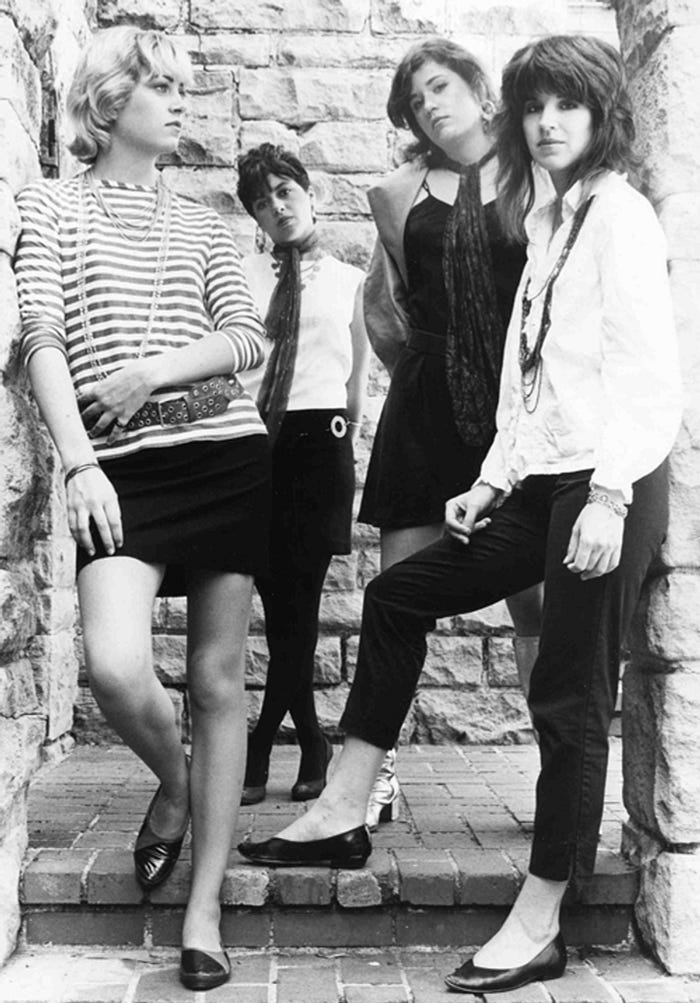
There’s a strange formula in rock which implies that popularity denotes quality. Wrong.
If anything, popularity evokes the almost instant erasure and overshadowing of what came before a band held the ability to sell out shows with single releases growing to seemingly define everything an artist represents. The early evolution of an artist’s life is often thrown out, cast from the timeline as popularity begins the unstoppable process of wiping history clear like the formatting of a hard drive.
Why does popularity provoke erasure and the unfair suppression of early beginnings? It’s almost as if popularity — in the form of chart hits and radio spin — indicates quality which, of course, it does not. Case and point? The 1981 to 1986 era of The Bangles.
The mainstream doesn’t get The Bangles. This poor reasoning is yet another to add to the list of explanations as to why they are omitted from “Women in Rock” retrospectives, documentaries and everything else in between. It often feels incredible to me that a band comprised of four guitar wielding women could continually be receptive to such poor treatment in comparison to other artists who did not, and who do not, hold the triple threat of being able to play, write and sing. This appears to be an apparent bias, the rock world growing aloof when conversation — if ever — shifts towards The Bangles.
Blindingly, there is always more attention given to soulless contemporaries from the 1980s era, ‘label fronts’ that were pushed into a recording studio and passed manuscripts as record label honchos sat formulating chart domination on pin boards three stories above, the music created below in claustrophobia [Stock, Aitken and Waterman “artists” like Bananarama and Mel & Kim. Shudder]. Pat Benatar is continuously covered in mainstream rock magazines and yet she never lifted a finger to an instrument. Benatar is also in receipt of continuous airplay on Planet Rock and regularly covered by Classic Rock Magazine yet rock stations refuse to play music by The Bangles. I’m continually amazed at the scale and depth of erasure The Bangles continue to endure. The Bangles are never the protagonists in their own story, a central realisation that inspired me to write this piece.
The Bangles were not Bananarama or Pat Benatar, they were their own act, standalone in a moment in music when women were not regarded as capable musicians but as robotic and unspeakable mannequins, and continually objectified in music videos. The Bangles solidified their formation in a garage in Brentwood, California, but they did not become Bangles overnight as some would often lead you to believe.

Sisters Vicki and Debbi Peterson grew up in a house in Northridge, California, where radio was in near permanent spin, with the mid-sixties sound making a strong and everlasting impression. Born two years apart, Vicki’s first electric guitar was a gift from her parents, an Electro ES-17 with a complementary eight-watt Rickenbacker amp, when she was in the 4th grade although her first experience with a ‘guitar’ had been with a Sears plastic copy when she was seven years old. At Rolling Hills High in Palos Verdes, Vicki became a cheerleader and sang harmony as part of a vocal group, but soon uncovered a musical path that was outside of the norm exuded by seventies radio.
In her older sister Pamela’s record collection, Vicki met the welcoming records of sixties pop and folk artists like Buffalo Springfield and The Byrds, and was soon inspired to begin writing her own songs. The love of sixties music was a mutual adoration shared by her younger sister Debbi as the artists became a refreshing change on a predominantly seventies perspective. At the height of Beatlemania in the sixties, The Beatles — a popular spin — ruled at chez Peterson in record form and in bubblegum cards. ‘Love Me Do’ had been one of the earliest songs Vicki had marvelled at, becoming a popular choice as she borrowed her Uncle’s copy of the song. Greatly inspired by the music happenings, Vicki formed her first band in high school — named Crista Galli upon graduation in 1976 — with her best friend and bass player Amanda Hills. Crista Galli’s name derived from a small bone at the back of the head and was — in Vicki’s own words — a female Simon and Garfunkel.
Crista Galli’s set was composed of mostly original material. Vicki’s compositions were in the style of Joni Mitchell but her true love was music by The Beatles and The Hollies. Crista Galli were forced to add in covers to acquire show bookings and struggled to hold down a permanent drummer. During rehearsals, Debbi would often joke around and air drum, hanging around the band as an unofficial but not quite member. The youngest Peterson shared the dream of playing bass — after her hero Paul McCartney — but the suggestion of Debbi becoming Galli’s drummer was first pitched by the group’s bassist Amanda to Vicki. Not owning a drum kit, Debbi borrowed a seat behind a friend’s kit to try out for the band, the instrument feeling natural after months of practice air drumming. After impressing her sister and the rest of the band with her skills, Debbi became an official member. She didn’t, however, own a drum kit so one was bought for her by Vicki (funded by her retail assistant job in a supermarket). At some point in 1976/1977, Crista Galli evolved into Aisha although the band’s name didn’t last long as confirmed by Vicki later:
“We couldn’t stand having a name that you couldn’t pronounce easily. Aisha means ‘life’ and ‘positive vibes’.”
As Aisha, the band played at high school functions, parties and youth centres before devolving in October 1978 after a guitarist left the group, and they became The Muze. The Muze were a three-piece band; Debbi Peterson, Vicki Peterson and Amanda Hills. During the same year, Vicki enrolled at UCLA and began studying to become an English major, The Muze began to acquire club bookings, gigging frequently. The Peterson’s band progressed into The Fans when they were joined by Culver City guitarist Lynn Elkind in May that year. Elkind had been playing guitar since she was 10 years old. Bored at college, Vicki dropped out to focus her interests on music with a dedicated belief that her band efforts were going to pay off while Debbi worked various jobs including a brief stint in McDonald’s. Both sisters now resided in Santa Monica.
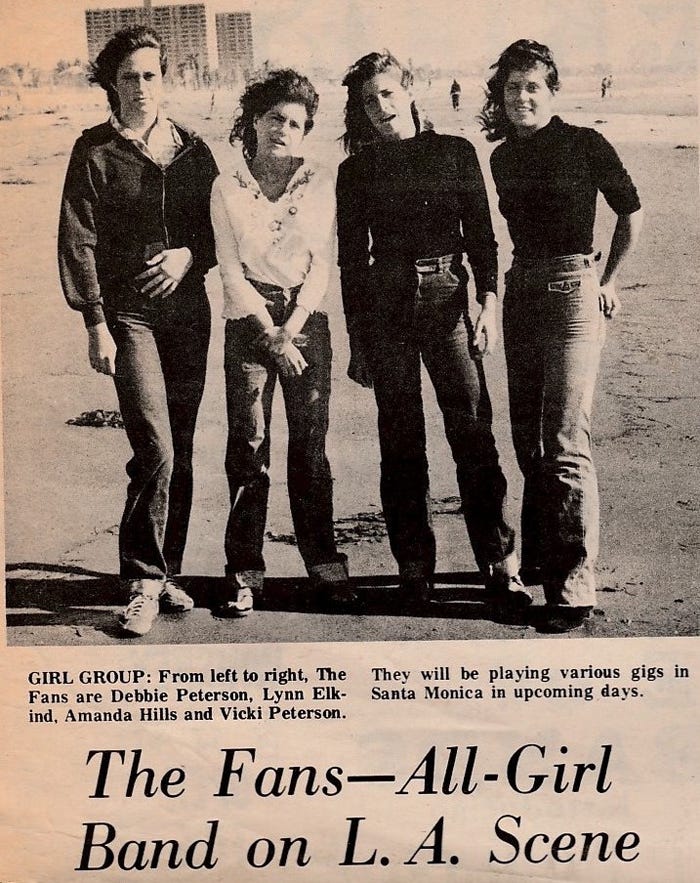
The Fans played one or two gigs a week, rehearsing in Santa Monica most other nights. Playing the club circuit in a vast array of venues such as the B&R Saloon, The Londoner, rustic downtown haunt The Sweetwater and The Troubadour, The Fans were strongly influenced by mid-sixties pop-rock. Their sets wove together both original and cover songs from the period.
The Fans were ambitious. “We want a record deal.” Amanda Hills stated in a interview, with the band declaring that they had not yet accepted any of the management offers they had been proposed. A gig write-up asserted that The Fans were a “refreshing group in a musical age of lost horizons and general lack of taste, or anything else that once supported our ‘60s values.”, The View, 8 November 1979. Playing cramped, sweaty clubs was something the Petersons enjoyed, the waves of the changing music scene beginning to be felt with Punk and New Wave raining high. The Fans knew The Knack, having crossed paths with the band on the club scene. Debbi stated in a 1979 interview that she had picked up playing skills from Knack drummer Bruce Gary while Vicki expressed her lack of surprise at the band’s commercial success with their debut album ‘Get The Knack’. Like The Knack, The Panics were another local group the band were friendly with. Regularly playing shows together, The Panics recorded ‘I’m A Fan’, a song inspired by The Fans.
The Fans changed their name in June 1980 to Those Girls. Now living in Hollywood, the Petersons shared an apartment with Lynn, the band’s guitarist.
“It was real difficult. You had to put flyers around, you had to bribe friends to come to the shows. Sometimes you played to a completely empty club, you play to the bartender and keep him entertained for the night. But we started like any other band starting in Los Angeles. You find a way into the club and then you start playing.” — Vicki Peterson
In early 1980, Those Girls gained coverage in a magazine article entitled ‘Meet The Girl Groups’ in Oui. In this interview, the band stated that they existed for music, not as male fantasy; a bold statement to make during an interview segment with a men’s adult magazine. Those Girls continued to gig, playing venues including Pippin’s Pub in Santa Monica, and L.A.’s Arena to the iconic Troubadour in West Hollywood, sharing bills with other local bands like The Unclaimed, Hyde, The Moderns and King Cotton & The Kingbins. The group devolved around December 1980. Lynn, their lead guitarist, had left Those Girls in mid-August. Amanda Hills, the band’s bassist, also officially left on Christmas Eve 1980 after opting to remain in college to pursue her studies. Determined to retain her interest in music, Lynn elected to form a new band and placed an ad for bandmates in local classified paper The Recycler. Faced with these departures, the Petersons remained driven and pushed on. Their musical journey was only just beginning.

Susanna Hoffs, prior to 1980, had been living in Berkeley and was in a band called The Psychiatrists/The Unconscious with her brothers, her neighbour David Roback and his brother Stephen. Playing guitar since high school, and electric since the summer preceding college, Sue had previously been involved in the arts but it was only during her time at college when her true rock ideals were awakened by a musical discovery of The Velvet Underground and Patti Smith. Sixties music had entered Sue’s life at an early age, a musical era which remained her strongest and most significant influence. During the sixties, the Hoffs household acquired advanced copies of Beatles records through a family friend that worked at Capitol Records. During her time at Berkeley, however, Sue had seen Patti Smith and the Sex Pistols performing and longed to be where they were; on stage.
The style and material being developed in The Psychiatrists/The Unconscious [the name referencing Sigmund Freud] was of the pop and surf song variety and not limited to droney medleys of Beach Boys (‘Little Honda’) and Velvet Underground (‘I’ll Be Your Mirror’) compositions, reverb turned all the way up to 11, the paving stones freshly laid for what would eventually become of Roback’s Mazzy Star. Sue would go on to state in 1983 that the project didn’t work out and upon her graduation from UC Berkeley in 1980, she set out to find a new band. How did she do this? By making a flyer, as was the style at the time.
The flyer created by Sue displayed a small list of her favourite bands; The Beau Brummels, The Blue Caps, The Byrds, The Go-Gos, The Last, Love and The Ventures. One girl who responded to the flyer was Maria McKee, future founding member of Lone Justice, who spotted the ad on the bulletin board of the Licorice Pizza record store adjacent from the Whisky A Go Go. McKee soon contacted Hoffs and the two met up but it was apparent that they both wanted very different things.
The music hive of the Whisky A Go Go was also selected for recruiting bandmates. One night when The Go-Go’s were playing [most likely during October — November 1980], Sue placed a stack of flyers in the Whisky bathroom hoping to entice the attention of other like-minded individuals in the crowd. These flyers, decorated with hand drawn Rickenbacker and Vox guitars, did not hold much success. They were tossed in the trash multiple times over only to be salvaged and replaced by Sue each time she returned to the bathroom. Eventually the flyers were ripped up from existence by the elusive flyer culprit and shredded into pieces. This action was made all the more ironic by Sue’s pasted flyer inscription of “must be nice”.
The flyer incident aside, Sue went on to place an ad in The Recycler, a weekly classified newspaper, with her dream band freshly formed in her mind, but only one other girl ever responded to her ad; Annette Zilinskas. It would be in yet another ad placed in The Recycler that Hoffs would find her band. This classified ad had been placed by Lynn Elkind, the recently departed guitarist of Those Girls who remained a roommate of the Peterson sisters, but it would be with a strange twist of fate that Vicki would be the one to pick up the phone at the other end of the line on 9 December 1980 (Lynn was out).
There was an immediate connection, a sense of familiarity as they spoke about their mutual love for John Lennon. The murder of the Beatle just a day earlier had sent shock waves throughout the world and was a central catalyst in propelling the future bandmates deeper into music. Sue and Vicki shared the same emotions as they spoke on the phone at length, consoling one another over the shock loss and many other things. There was an immediate connection, a sync, but ultimately, Vicki felt that ethically she couldn’t steal a possible bandmate from Lynn. Sue was, after all, responding to the Recycler ad placed by Lynn. Lynn soon contacted Sue but it was clear that the vital spark of chemistry required just wasn’t there. Weeks later and now guilt free of commitments, Vicki reconnected with Sue. The remaining members of Those Girls now had a possible bandmate.
Meeting for the first time at Susanna’s house in her parent’s converted garage in Brentwood in January 1981, the Petersons named the bands that influenced them. They shared knowledge of The Hollies, Arthur Lee and Love, they knew who The Grass Roots were, an essential ingredient as Sue later noted, and the chemistry was instantaneous. It clicked. They held an intense love for The Beatles, another long standing influence, their own fixation mirroring Hoffs. The Petersons listened to demo tapes from Sue’s Unconscious era with David Roback and exchanged their own. Sue’s cassettes featured The Velvet Underground’s ‘I’ll Be Your Mirror’ and some originals including a surf instrumental entitled ‘Speedway’. They then played together for the first time. Harmonies came easy for the trio. The Petersons taught Sue the two-chord progression of Jefferson Airplane’s ‘White Rabbit’ and everything else came together. The Colours were born virtually overnight.
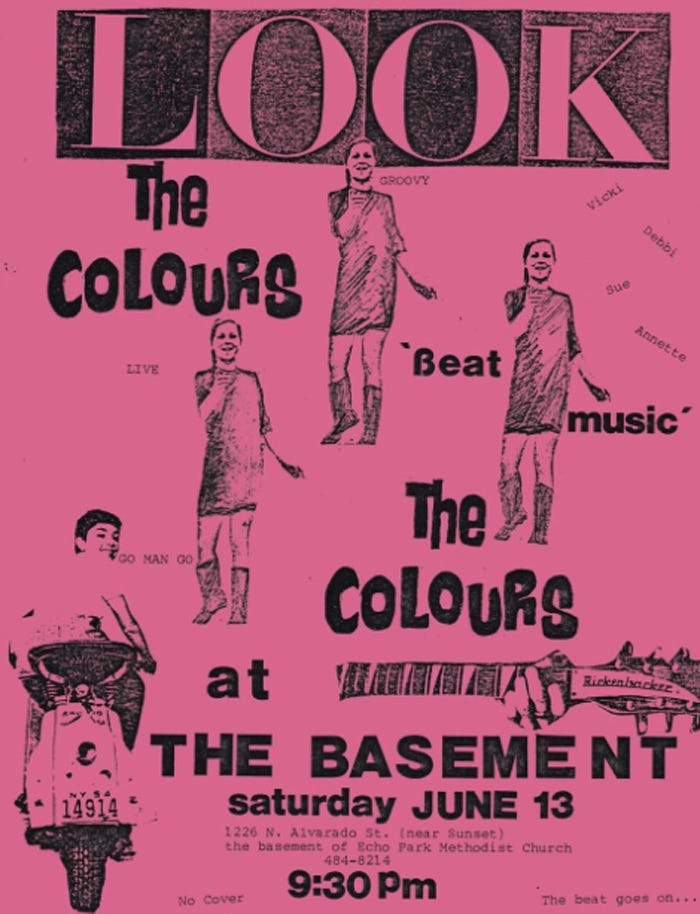
Gaining momentum, The Colours played in church basements and local venues including H.J’s rock Club in Hollywood. Annette Zilinskas, the first and only girl to respond to Susanna’s ad in The Recycler, soon joined as sometime member (her name features on a Colours flyer from June 1981). Zilinskas had been playing guitar for about six years and had previously worked in a record store. Prior to joining, Annette had been one half of a country duet, singing Hank Williams numbers at Californian venues including The Troubadour. Amanda Hills, bassist in the Peterson’s earlier bands, also joined The Colours for live dates in August 1981 as the band did not have a bass player.
The earliest recordings of Colours era songs date from June 1981 and are housed on a TDK SA-C60 cassette tape. This recording session came around because a friend of a friend was studying the art of recording and The Colours became the subject of their experimental project.
The first song on the demo tape was a cover of The Turtles’ 1967 song ‘Outside Chance’, featuring lead vocals by Vicki. The second was ‘Call on Me’, a number co-written by Hoffs, D.Roback and V.Peterson. The third was ‘Real World’, the very first song to solely be written by Hoffs and V. Peterson, marking the beginning of a writing partnership that would last until the decade’s end. The tape’s final song was a cover of Paul Revere & The Raiders’ 1965 song ‘Steppin’ Out’. These demos would eventually be officially released on 2014’s ‘Ladies and Gentlemen… The Bangles!’ but were once aired on KROQ during the mid to late eighties. These recordings predate the band’s name change(s) from The Supersonic Bangs — a name that was only briefly held and inspired by a July 1965 Esquire article about Sixties youth culture — to The Bangs. The name change from The Colours to The Bangs was gutsy and short with recognisable linkage to the sixties, and unfolded in August 1981.
The members of the band remained active supporting other acts, as befitted the highly collaborative culture of the Paisley Underground. Around this period, Debbi Peterson guest drummed on L.A. scene alumni Alisa’s ‘I Love An Ape’. The Bangs provided backing vocals to Jane Bond & The Undercovermen’s 1981 song ‘Run To Him’ and 1982’s ‘Come On Up’. Susanna Hoffs collaborated with Harvey Kubernik on a track entitled ‘Noh Comment’ (which was eventually released on ‘The Radio Tokyo Tapes’ in 1983). Vicki, at this time, handled show bookings and promotions.
The Bangs didn’t wish to send a demo tape to major labels and, taking to their punk ethos, chose to secure their name on a self-released 45 entitled ‘Getting Out Of Hand’. Pooling together their savings accumulated from their day jobs — Debbi worked in retail, Sue in a ceramics factory and Vicki at Laird International Studios — they recorded their two-track debut for $35 at Radio Tokyo, a ten dollar an hour studio in November 1981. Radio Tokyo had been recommended to The Bangs by Vitus Matare of The Last. Situated a few blocks away from Venice Beach, Radio Tokyo was a converted house studio and owned by Ethan James. Carpets were tacked to the walls, and windows were masked out, with equipment that was worn but well loved. It was, however, a welcoming place to record. Black Flag, 100 Flowers, The Last and Sonic Youth were just a handful of the many artists to record within its walls. The Bangs recorded ‘Getting Out Of Hand’ in just three and a half hours [although one source claims the recording session was in fact sixteen hours.]
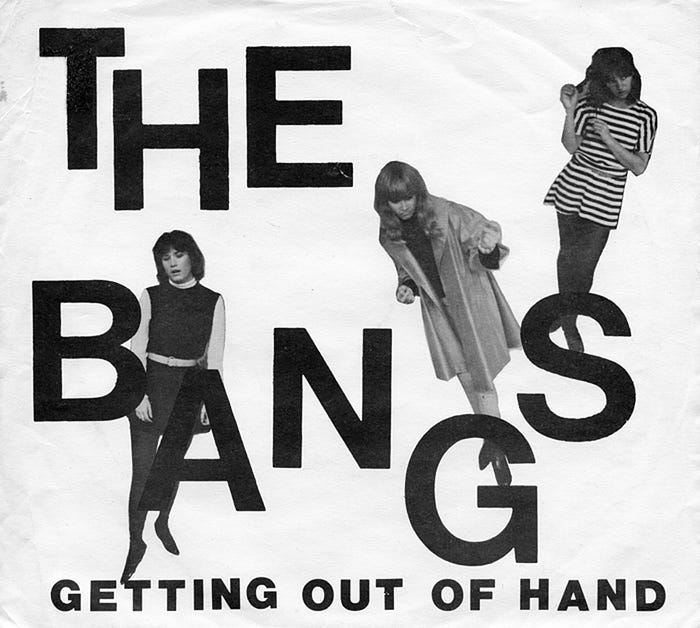
Forming their own label, Downkiddie Records, The Bangs not only cut the single but also packaged and distributed it (the 45 was packaged in Sue’s Brentwood garage where the band was formed). The sleeve was xeroxed at Copy Spot in Santa Monica, where the band would often visit to copy gig flyers. ‘Getting Out Of Hand’ would be released on 19 December 1981.
The A-side ‘Getting Out Of Hand’ was written by Vicki, and remains a much underloved gem. The song, although an introduction, showcased the distinctive sound of The Bangles that the world would come to recognise. The single’s B-side ‘Call on Me’ was written by Hoffs, V. Peterson and David Roback, and previously existed as a Colours demo. ‘Call On Me’ had originally started as a country song, having been recorded by Hoffs and Roback on the UC Berkeley campus [a recording is known to exist]. The Bangs felt that the duo’s original version didn’t fit their style so with Vicki’s help, ‘Call On Me’ was reconstructed to an up-tempo number layered with harmonies. An unreleased alternate demo version of ‘Call On Me’ recorded by The Bangs has since surfaced. Although the exact date of the recording is unknown, it was most likely recorded in 1981. This version features a much slower tempo and a lyrical variation which wouldn’t make it to the final product on vinyl.
The ‘Getting Out Of Hand’ 45 is drenched in the essence of the sixties, almost like it had arrived from 1966 via time machine, from the vocals to the guitar, to the oversized one-fold sleeve and black and white images taken by Roback on the front and rear. The single was recorded on an eight track machine. Vicki played a 1967 Stratocaster as well as a 12-string borrowed from members of The Last. According to an early interview Vicki Peterson gave in 1982, at the time of recording ‘Getting Out Of Hand’, Annette Zilinskas, sometime Colours bandmate, remained one half of a country duo alongside Greg Davis so both Petersons played bass on the single; Debbi on ‘Getting Out Of Hand’ and Vicki on ‘Call On Me’, the release being completed as a three piece and arriving with the simple typewritten message of “To Marji, Dave, Ian and Max Bang. Merry Christmas”.
“We sat down one day and said, ‘We are a record company and we’re called Downkiddie Records.’ It was that simple!” — Vicki Peterson
In January 1982, KROQ DJ Rodney Bingenheimer played both sides of ‘Getting Out Of Hand’ on his show after being handed the single by the band. ‘Getting Out Of Hand’ became a popular request and once made Bingenheimer’s Top 20 requests list marked at #3 [Flipside Fanzine #34]. The single also received airplay on KNAC-FM in Long Beach and appeared in LA Weekly’s chart to Debbi Peterson’s joy. The initial pressing of 400 copies (blue label) almost immediately sold out (the band spent $800 dollars pressing a total of 1000 copies. Yellow labels were added later). The success of the debut single sparked a demand for live shows and subsequently meant that the band had to evolve into a quartet. With Susanna’s ad still running in The Recycler, she was reconnected with Annette Zilinskas. As a rhythm guitarist and singer, Annette agreed to hone her skills on bass when asked. The Bangs now had their fourth member. Following the 45, the band began to gain coverage in an array of zines including Flipside and NO MAG.

NO MAG was a tabloid-style fanzine which chronicled the L.A. underground and featured punk-rock bands and artists as well as pages on fashion and design. The Bangs recorded a radio ad for the zine after performing the jingle at NO MAG’s release party on 26 March 1982 [sources claim they were approached to record the jingle by NO MAG founder Bruce Karlberg].
‘NO MAG Commercial’ was recorded at Radio Tokyo and would eventually be released on Ear Movie Records’ ‘The Radio Tokyo Tapes’ compilation in January 1983. This was another self-released song published on the band’s own Downkiddie Records label. It can be assumed that ‘No Mag Commercial’ was recorded around the time of NO MAG’s 8th issue because the jingle [accredited to Hoffs and Peterson and to the tune of ‘Getting Out Of Hand’] references the tagline on the front cover (“Pop trash. Noise music. Nancy Reagan.”) and the two other bands which accompanied The Bangs on the release party bill; Channel 3 and The Descendents. The Bangs were the only non-punk band to play at the release party, a detail which initially intimidated the band although they were well received.
Pre-dating the band’s coverage in NO MAG #8, The Bangs made their film debut with a cameo role in The Haircut. The Haircut, a 22 minute film, starring legendary director John Cassavetes was written and directed by Tamar Hoffs. The band’s cameo featured The Bangs as a four piece with bonus member Marji Mize [the ‘Getting Out Of Hand’ 45 includes a dedication to her. Marji became president of the band’s official fan club; Bangles ‘n Mash in March 1983, known to members by the alias of ‘Mojo’]. Each Bang is credited as “Bobby Russo’s Daughter”. The Haircut would go on to be screened in the Un Certain Regard section at the 1983 Cannes Film Festival, two years before the band made it to Europe. The film features jangly, mostly instrumental music, bringing forward the possibility of further early unreleased material.
The introductory press release describing The Bangs stated:
“Vicki Peterson and Susanna Hoffs come up with fresh, true-life songs and Debbi Peterson supplies them with a back beat that dares you to sit still. (try it…) Onstage, the girls are fun and frenetic (frank, fractious, frazzled, friendly…) and if you corner one of them backstage, you’ll probably find yourself out-talked and out of breath in no time.”
Beginning in March 1982, The Bangs began to play the club circuit, gigging in such venues as The Barn at UC California, Club 88, The Cathay de Grande, Club 88, Topanga Corral and the Grandia Room. According to Annette Zilinskas, the first show The Bangs ever played was in a back lot of Laird Studios in Culver City, California. The Bangs’ second ever show took place at the house of Sue’s then boyfriend. Although a member of The Bangs, Annette Zilinskas, for a time, briefly joined the lineup of Pleasant Gehman’s Screaming Sirens.
The Bangs promoted themselves on low-fi, customised Xeroxed flyers and shared bills with bands including The Dream Syndicate, The Longryders, The Last, Redd Kross and The Salvation Army (and even Billy Idol) becoming an active member of the flourishing ‘Paisley Underground’.

The ‘Paisley Underground’ term emerged in Autumn 1982 during an interview with Michael Quercio of The Salvation Army/The Three O’Clock in LA Weekly. He cited the ‘Paisley Underground’ when asked to describe The Bangles, The Rain Parade and The Three O’Clock sharing the same bill. According to Quercio, the idea of playing bills together had first been suggested by Susanna. The bands were friends and had once taken an acid-tinged camping trip to Catalina Island where they bonded over their love of sixties music. It was refreshing at a time when dust was beginning to settle on New Wave and the unfolding Hardcore club scene was both violent and alienating. The Bangs were just one of the many bands who struggled to acquire club bookings because of this. The friendship between the like-minded musicians became a welcoming community at a time when the L.A. music scene had grown stagnant. The movement inspired collaboration and wove together a strong network of support as the friendly bands began to share bills together, with the gigs attended by a vast array of gig-goers; from punks to fans of rockabilly. “All these labels get a little dull after a while.” Sue said of the movement in May 1984:
“They talk about the ‘Paisley Underground’ and all that garage stuff, there’s no conscious image we’re striving for. There are sounds from the ‘60s we grew up loving but we’re definitely not a revival band.”
This era is documented in rare and unsurfaced footage (at least one film exists of The Bangs rocking out with The Salvation Army at a venue in Huntington Beach) while it is preserved in many colourful flyers and gig photographs. The Bangs once threw a party in the Hollywood Hills that was attended by many members of the unfolding scene. Rain Parade’s 1982 single ‘What’s She Done To Your Mind?’ was not only written about Susanna Hoffs but it also featured her eyes on the artwork. The Paisley movement often collaborated on stage. Steve Wynn, of The Dream Syndicate, once joined the band at the Anti Club, playing harmonica [most likely on ‘How Is The Air Up There?’]. The Class of ‘82 was an influential moment for each band and now, 32 years later, the ‘famous four’ of The Paisley Underground are still recording together. Released on Black Friday 2018, The Bangles, The Dream Syndicate, The Rain Parade and The Three O’Clock have reunited to release ‘3x4’; an album featuring cover songs from the Paisley movement. The biggest collaboration between the scene alumni in the 1980s, however, didn’t begin until 1983 as supergroup Rainy Day emerged to record an album together.
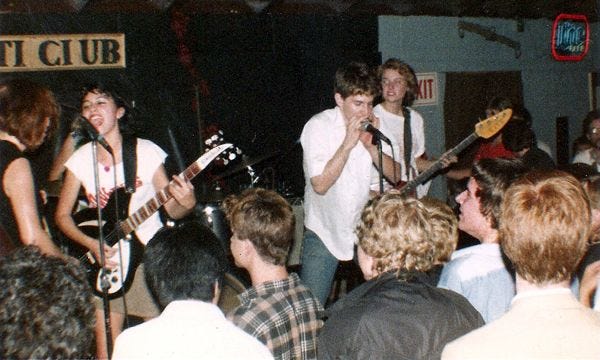
Covers performed around 1982 included The Changin’ Times and The La De Das ‘How Is The Air Up There?’, Love’s ‘7 and 7 Is’, The Merry Go-Round’s ‘Live’, The Seeds ‘Pushin’ Too Hard’ and Simon and Garfunkel’s ‘Hazy Shade of Winter, the latter led by Debbi. Covers were already becoming an essential component of The Bangs’ set, a factor which would go on to be a critique often expressed in write-ups, reviewers feeling that the band at this time relied too heavily on covering classic sixties beat artists.
‘The group tends to cop Beatles riffs (a couple of songs bear the same “Taxman” like bass run) and even though The Bangs do excellent versions of Simon & Garfunkel’s “Hazy Shade of Winter” and The Seeds’ “Pushin’ Too Hard”, the group should really concentrate on its original tunes.’ wrote The Los Angeles Times on 8 May 1982 (BANGS IGNITES ROCK MUSIC AUDIENCE).
The band’s covers of these songs would go on to become staples in their set, lasting for much of the decade. The Seeds cover was blistering and punchy with vocals by a drummer who could play and sing simultaneously which is no mean feat. ‘Hazy Shade of Winter’ would be revisited in 1987 by a much glossier band but there’s something very sixties about Debbi’s original take on the song. ‘How Is The Air Up There?’ would be dropped almost completely from the band’s setlists beginning in 1986 although it would crop up occasionally. Interestingly, there was at least one show during 1986 that featured two EP era tracks; a rarity for the year of ‘Different Light’. This show took place on 23 October 1986.
“Sixties culture and music are part of the bloodstream of The Bangles.” — Debbi Peterson
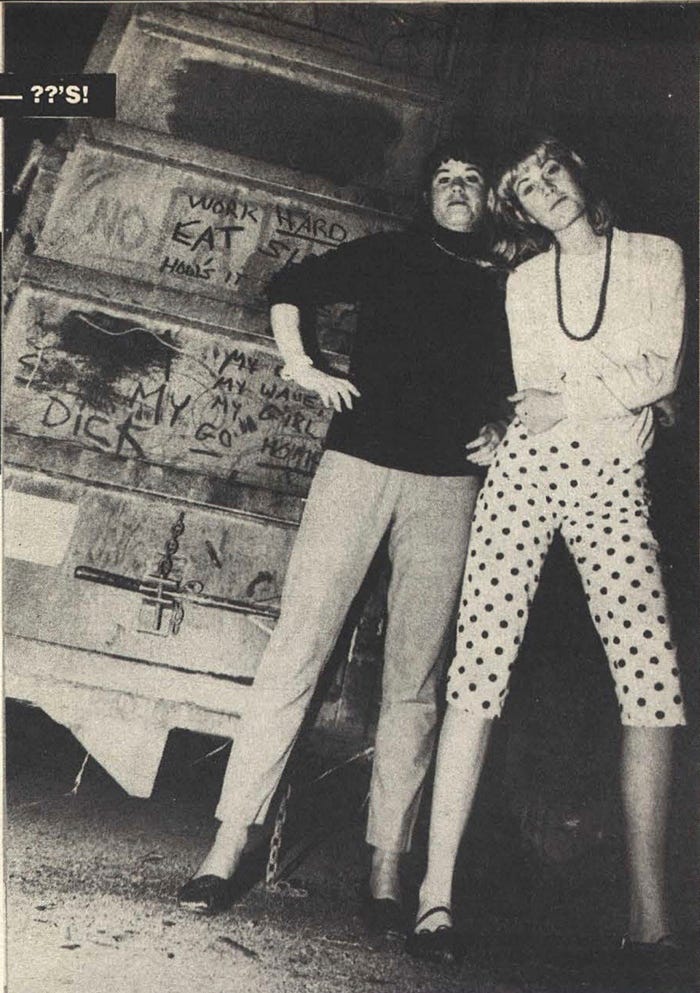
The Bangs were gaining coverage and momentum, although they had played less than ten shows by the end of June 1982. An early 1982 show attended by music producer Miles Copeland [brother of The Police’s drummer, Stewart Copeland] gained them their first label interest and, ultimately, their first recording contract. At this particular show, Copeland approached Debbi and the drummer had no idea who he was. They struck up conversation and soon the band had a meeting with the founder of I.R.S. Records, with negotiations beginning towards the end of June 1982. This meeting unfolded with a tape recorder in hand because the young band wanted to record everything. Wary of the label for being the same as The Go-Go’s, this initial concern marked the beginning of a comparison that would haunt the band for decades. The Bangs eventually came to an agreement with Copeland after being convinced that they would be treated as their own act and signed with the label. Now with a management contract with Los Angeles Personal Direction [LAPD], work began on recording what would become their debut EP on Faulty Products, an independent record label and distribution company of I.R.S Records.
The EP was recorded at Chateau Recorders in Los Angeles in mid-1982 over three days. Chateau Recorders was owned by Ken Scott, a British engineer of EMI artists including The Beatles and producer of many artists including David Bowie [Scott produced Hunky Dory and Ziggy Stardust and the Spiders from Mars]. Craig Leon, who produced The Ramones debut album, was selected to helm the recording. The EP was tracked on a Trident A console, reminiscent of those used at Trident Studios in London during the 1960s, and included much of the band’s earliest material.
The very first song penned solely by Hoffs/V.Peterson — ‘The Real World’ — was placed fittingly as opener. Inspired by The Beatles’ ‘If I Needed Someone’, ‘The Real World’ became the official introduction to the world of The Bangs. ‘I’m In Line’ was one of the very first songs written by Hoffs and the Petersons, and gifted Debbi her first lead vocals cemented on vinyl with distinct echoes of The Beatles’ ‘Taxman’ (or The Jam’s ‘Start’). The inspiration for many of the band’s songs were pulled from their own lives [‘I’m In Line’ was about a love of Debbi’s]. ‘Want You’ was written and led by Vicki and reflected the heavier, punchier side to the band that was displayed when playing live. According to Peterson, ‘Want You’ was penned in just seven minutes. ‘Mary Street’ was pulled together from a conjured character, a la The Rolling Stones’ ‘Stupid Girl’ and ‘19th Nervous Breakdown’, with Vicki describing it at the time as a modern day ‘Georgy Girl’.
The Bangs revived ‘How Is The Air Up There?’, a cover of The Changin’ Times and The La De Das that had been originally unearthed on a mixtape gifted to Peterson. The Bangs also considered recording a 1940's Dr Pepper commercial as well as a 1967 track by The Electric Prunes but ran into trouble with acquiring rights and sponsors. Producer Craig Leon played piano on ‘The Real World’ and ‘Mary Street’ while Ethan James — the owner of Radio Tokyo — joined him on segments of ‘The Real World’. The EP’s lead guitar work was achieved with a Les Paul, Vicki utilising Fender Deluxe and Super amplifiers.
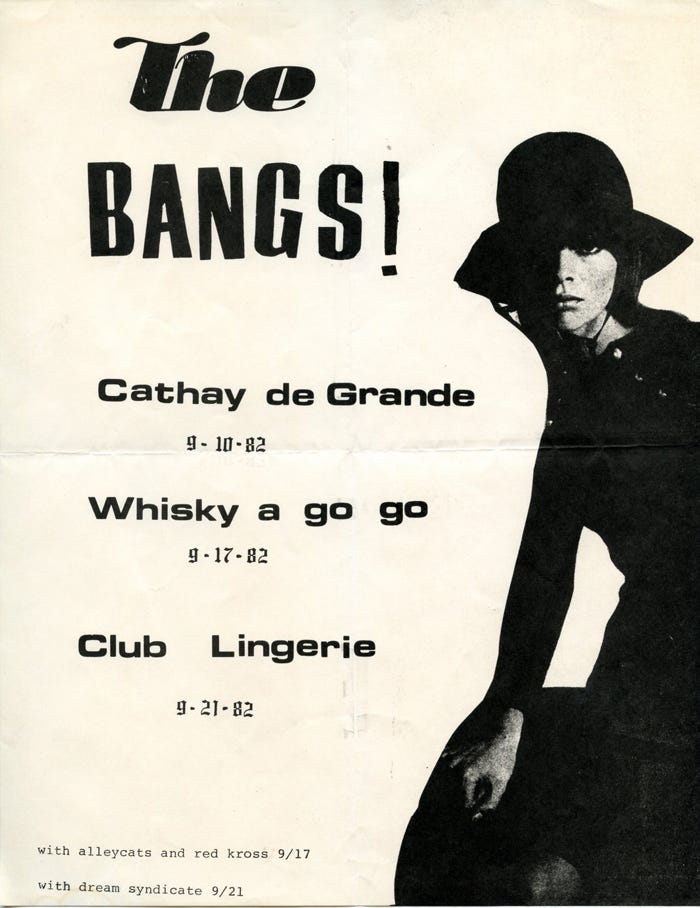
The EP was scheduled for October, the release party taking place on the 7th of the month at the Lhasa Club in Hollywood. The Lhasa Club was located on a small, dark side street off of Santa Monica Boulevard and held a capacity of just 100.
The Bangs’ slowly simmering popularity captured the attention of another band and another Bangs. This New Jersey band were all-male and they wanted to retain their name after releasing an EP on East West Records. The New Wave band desired $40,000 for rights to the name. This served the band with a dilemma of a forced and sudden name change — its own identity crisis — which delayed the release of the EP until 25 January 1983 as the release artwork had to be amended. The Bangs couldn’t, however, completely erase the roots of what they had solidified across the local music scene during the past year so they retained the ‘Bang’ and added a few letters. They were now Bangles. There was an implicit Beatles reference held as well as sharing the namesake of a 1967 song title by The Electric Prunes. The name change saddened the band. “It was traumatic.” Vicki stated,
“We felt really bad. It was like having to change your personal name. We had already gathered a following under The Bangs and had worked hard. We felt we were The Bangs, not something else.”

The final Bangs era shows took place in late October 1982, the gigs which would, in turn, be the warm up to their first major tour. Miles Copeland booked them with little more than 5 days notice with the news that they would be opening for I.R.S mainstays The Beat.
Opening for The Beat — The English Beat in America — would serve the recently crowned Bangles with their first major hard to please crowd. Being an opening act is never easy but when an all-female garage band is placed in front of a boisterous and predominantly male, pseudo punk audience expecting content similar to the main act and not much else, it’s even tougher. There are mixed reviews from the six week tour with writers appearing to be confused and alienated by a band that they viewed as mere sixties revivalists and stigmatised as a “girl group”, a critique which would last for much of the band’s tenure and, arguably, remains to this day. The band were hit by milk cartons and chewed gum one night, and were booed off the stage during the December night they played at the Hollywood Palladium, the crowd sharing derogatory and sexist comments between themselves [noted by attendees]. The tour covered up and down the coast and Canada, The Bangles playing the Toronto Concert Hall where they had money stolen from their dressing room. It was, in all, an introductory experience.

The first vinyl released under The Bangles name was not the self-titled EP. It was ‘Bitchen Summer (Speedway)’. ‘Bitchen Summer (Speedway)’ was released on Posh Boy’s Rodney On The ROQ Vol. III compilation on 12 December 1982 although the song had been receptive to local radio play under The Bangs name, something the band were thrilled about. ‘Bitchen Summer’ was an Unconscious era song, written by Hoffs and Roback, that had been born out of an admiration for The Ventures, and was produced by Dave Peterson. Beginning as an early surf instrumental that held the working title of ‘Speedway’, ‘Bitchen Summer’ would later be revived for The Bangles summer tour of 1987. Vicki repeatedly stated throughout the decade that ‘Bitchen Summer’ was her favourite Bangles record and once included it on a mixtape she curated in 1985. The exact date of the ‘Getting Out Of Hand’ reissue remains unknown, the band’s label Downkiddie Records re-pressing it under the freshly christened Bangles name, but it was most likely released in January 1983 (some reissues included a small square hype flyer that advertised the band’s 25 January 1983 release of their debut EP). The reissue of ‘Getting Out Of Hand’ was distributed with four colour variations of the label in blue, green, red and yellow.
Returning home from their first major tour, after playing almost every night for six weeks, the freshly crowned Bangles were tighter. Just in time for the dust to settle and for their EP to finally be released on I.R.S’s Faulty Products label on 25 January 1983. The EP was sent to journalists with an accompanying letter, hand signed by all four members, that stated; “Dear friends, you have now received our new EP. Take it out. Put it on. Dance around the room. Love, Bangles.”
The band’s opinion of the debut EP fluctuated over time. “It was pretty primitive.” Vicki said of the mini album in May 1984,
“It didn’t seem quite natural enough to us. We wanted it to sound like we were sitting in your lap singing into you ear but it came out like the vocals were coming through several layers of gauze.”

The Bangles EP became a popular spin on college radio, something which pleased the band. KZEW-FM DJ George Gimarc was so enamoured by The Bangles that they would eventually record the theme song to his curated Rock & Roll Alternative Program, a radio show which the band appeared on. The Rock & Roll Alternative Program was one of the first regular Punk and New Wave radio shows in America.
There are at least two versions of the radio theme. The original (released alongside Gimarc’s comprehensive 1997 ‘Post Punk Diary 1980–1982’) featured the band introducing the program title at the beginning of the song. The version issued on 2014's ‘Ladies and Gentlemen… The Bangles!’ does not.
Gimarc reviewed the EP on his show in early February 1983, calling it a musical cross between The Mamas & Papas, The Beatles and The Lovin’ Spoonful. Gimarc also remarked that the comparison between The Bangles and The Go-Go’s was unfair because they both happened to be all-female. The Bangles, he said, were more gutsy and rocking with their guitars. Trawling through the archives, it doesn’t take long for the comparison between both bands to appear. It was created as soon as the band began gaining momentum. This unfolded for three unimaginative reasons: they were comprised of women, both from L.A. and because both bands had signed with I.R.S. Initially, the label connection arrived as a worry. They didn’t desire the tag of being, in Vicki’s own words, a poor man’s Go-Go’s. They were what they wanted to be, in the same ethos that inspired the self-release of ‘Getting Out Of Hand’.
Why does the comparison to The Go-Go’s still weaken the band’s efforts in rock acceptance? Is image really this vital in music? Both are different bands and that might be a radical notion to some [look out for the standard Twitter polls asking which band was the “best”. Spoiler alert: they both were] but they remain incredibly contrasting bands. They could never be identical just because they share the same era and the same gender. I often find that there’s an almost hostile approach gifted towards The Bangles when mentioned in the same paragraph as The Go-Go’s. Stop the comparison and appreciate both bands for what they were, and what they are, because they’re equally deserving of your love. A lesser known fact is that both bands were friendly and even played together in August 1984, something which is often omitted even by fans. This is probably lesser known because the world loves black and white tabloid headlines of female rivalry. Scandalous? No. It’s just an outdated cliché that deserves to die a quick and painful death. Similarly, on this note, there was a recent exchange between two fans via the notes section on an image I had posted on my blog. These fans were conversing about how the “rivalry” between The Go-Go’s and The Bangles had “destroyed” both of their careers. But… what rivalry? Women versus women? Imagine placing your “fact” on the copy screen for it to be xeroxed. You pull it out after it has been copied and now it’s a little fainter, only for the process to be copied once again and repeated, on and on, until the “fact” you had to begin with is no longer the same. That’s how I describe the endless misconceptions about The Bangles. Do your research before you accept whispers — or YouTube comments — as facts.
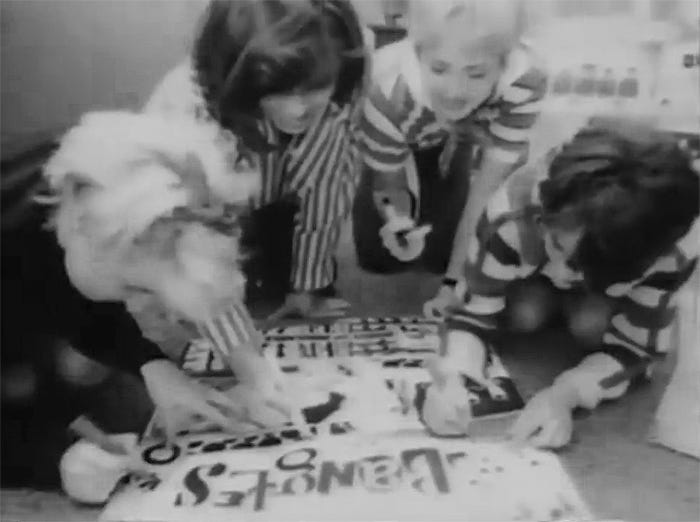
With the band’s debut and self-titled EP finally released, a music video was filmed to promote the opening track ‘The Real World’. The video was completed on 25th March 1983. It was directed by Frank Delia and featured L.A.’s Chinatown in the rain as well as the band performing at Central [the venue would go on to become the Viper Room]. According to an article on Delia in The Los Angeles Times, 2 September 1983, the music video for ‘The Real World’ was made for just over $9,000. In April 1983, ‘The Real World’ was remixed by producer David Kahne and released as a promotional 12” single that featured a glossier but more subdued version of ‘The Real World’. The Bangles had first met Kahne after their show at the Old Waldorf in San Francisco on 9 February 1983.
When Faulty Products folded in May that year, the EP was reissued on I.R.S. Records and released on 12 July 1983. The EP was also reissued in 1987 by Illegal Records, a strand of Miles Copeland’s empire. ‘Mary Street’, ‘The Real World’ and ‘I’m In Line’ from the debut EP would be reissued in 1988 as a 3” CD single. This version of ‘The Real World’ is the Kahne remix and is a few seconds shorter than the previously released version. The CD artwork is also a slightly modified reworking of the original EP. These were the only EP related releases of the 1980s although some tracks would be included as b-sides on later singles [marketed as being ‘previously unreleased’]. According to an interview given in April 1983, the debut EP had sold over 22,000 copies in the first 6 to 7 weeks upon release in January 1983.
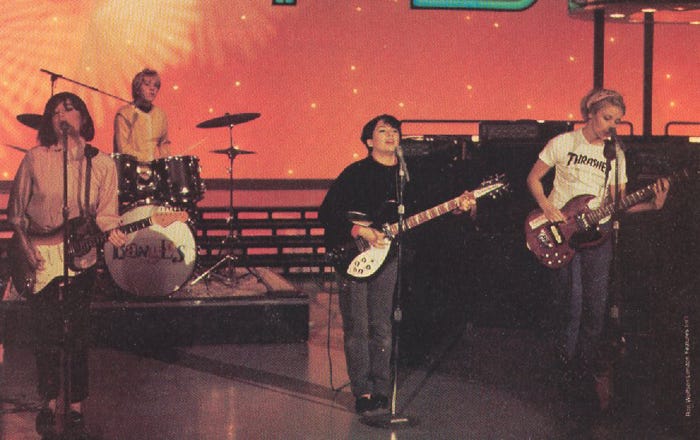
March 1983 saw The Bangles make their TV debut. On 26 March, the band appeared on American Bandstand, lip syncing to ‘The Real World’ and ‘Want You’. They were interviewed by Dick Clark, looking and sounding like they were from an earlier time. The band’s rough edges were, seemingly, too much for TV as Annette Zilinskas was forced to cover her Thrasher t-shirt during the performances [which features in the above promotional still]. The band’s second TV appearance was filmed at Hollywood’s Chaplin Soundstage in March 1983 and aired the following month when The Cutting Edge, an I.R.S produced music program, began on MTV. Interviewed by host Jeffrey Vallance, the band shared their influences and inspiration in being drawn towards music between a round of crazy golf. Miles Copeland viewed The Cutting Edge as an effective advertising tool for I.R.S. artists at a time when the vast majority of the music industry had not fully utilised the marketing value held by music videos.
The band’s gigs at Magic Mountain in Valencia on 27 March 1983 are of note because they were attended by Columbia Records talent scouts, and helped bring a recording contract to the table. Displaying their ever present sixties oozed charm and jangly guitars in both early and late sets, these performances are immortalised in bootleg form and featured one new original, ‘Renaissance Man’. Not much is known about this number, only that it became a prominent addition in setlists from this era but there’s a strong possibility that it exists in demo form in the archives, and was most likely a Hoffs/V.Peterson collaboration. The move from I.R.S. to Columbia Records unfolded around March to April 1983, although a 1984 press release for ‘All Over The Place’ states that the deal with Columbia Records was officially formalised in August 1983. Three days after the Magic Mountain shows, The Bangles opened for Sparks at the Anaheim Convention Centre. The L.A. Times review, 1 April 1983, noted that the show was opened by “a set of infectious pop nuggets”. The band’s popularity was growing with coverage in newspapers — local and mainstream — and continued in zines, although the band’s official fan club, freshly founded, had just 50 members in 1983.
The first major headline tour for the band began in April 1983, their biggest tour since opening for The Beat in Winter of 1982. Their final local gig — and warm-up for the tour — took place at Costa Mesa’s Concert Factory on 2 April. The East Coast side of the tour was advertised in music papers, with the ad enthusiastically telling readers to ‘Watch for more Bangles dates in your area!’ After the band’s show at Nashville’s Cantrell’s on 22 April 1983, Vicki said:
“We’ve been getting a good response but the shows up until now have not been publicized at all, so people are just hearing about the show on the day of the show. We’ve been playing to 100 people sitting in a club and we’ll get two encores from those 100 people but it’s still kind of disheartening.”
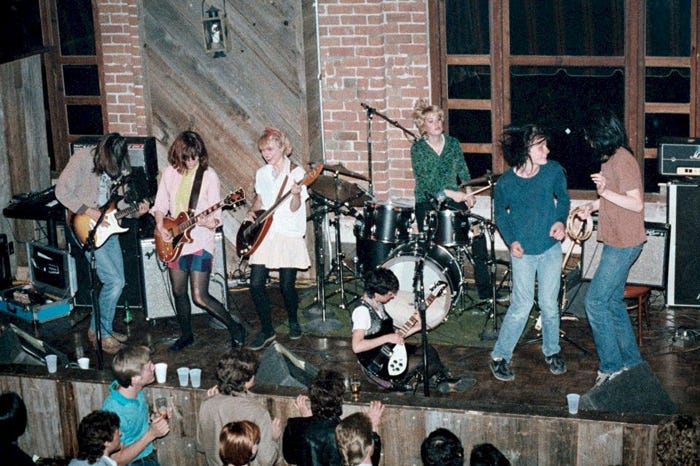
Annette Zilinskas left The Bangles in May 1983. Her final performance with the band took place at L.A.’s Country Club on 30 May to a sold-out crowd. Months before her departure, Vicki and Sue gave an interview on KROQ in early 1983 in which awkward silences paint an obvious sign that things weren’t working out. This departure left the band without a bass player and they needed to act fast. Zilinskas would go on to join Blood On The Saddle the very next day after leaving The Bangles, referencing her time in the band in later interviews all throughout the decade. Of Zilinskas’ departure, Susanna said in May 1984:
“Annette wanted to do something else even though she liked this band. We wanted to get a person who wasn’t indecisive about making it a career commitment, who’d be a Bangle family member.”
Michael Steele, who had been sharing a house with Vicki, would join as bassist. Steele liked The Bangles and wanted to be in the band, having been first introduced to The Bangs by Sid Griffin, a one-time roommate of Debbi Peterson. Before joining the band, Michael would often ask Vicki — normally in the kitchen — how the band was going, a coy hint that she later admitted was a bid to join the band. She eventually got her wish. Years before this took place, Susanna Hoffs had attempted to connect with Steele in a bid to form a band in the Pre-Bangles age but Michael did not return her calls.
“It’s great having a former Runaway in the band.” Vicki said of Michael’s addition in May 1984:
“I remember being in highschool and reading Robert Hillburn’s first article about The Runaways. I cried- I thought, ‘that’s it, they’ve stolen my dream’. I’d always wanted to be in a female band that got real recognition.”
Steele’s addition was noted in the L.A. Times on 10 July 1983. The first live show she played as a Bangle — repeated sources support this — took place at the Cathay de Grande on 31 July 1983. Steele, however, a resident to the L.A. music scene was familiar with the venue, many of her earlier bands having previously played there. This July gig, of which a bootleg exists, displays a pivotal and almost erased era of The Bangles. Opening the gig with ‘Find It’, the catchy tune from the 1970 cult film Beyond The Valley of The Dolls and its fictional band The Carrie Nations, The Bangles found it — ‘it’ being rock ‘n roll. Were they rough around the edges? Yes. Was their sound a little shaky in places? Completely. But were they having a good time? You bet they were.
It has always struck me in bootlegs, especially from this era, just how much the band sound like they were dancing around the stage, the strum of jangly guitars lingering no matter how crackly or faded the recording might be. There’s banter and an ever present energy, a sharpness which I often feel separates The Bangles from many other artists. Bootlegs from 1983 are rare but more exist than you might think. It’s just a case of digging around in that box and bringing them to life for the digital era. I wish more people would.
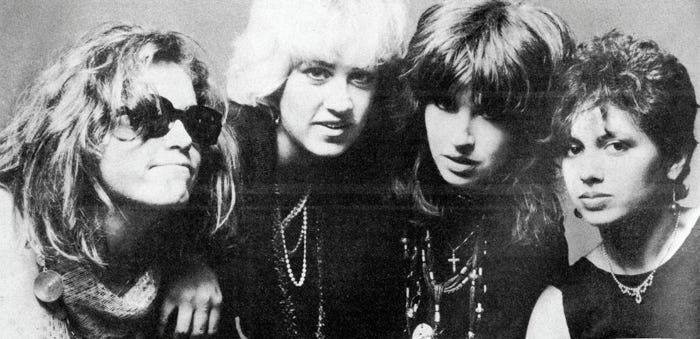
In July/August 1983, recording would begin on a side-project. Rainy Day, a super group comprising of Paisley Underground alumni, would converge. This collaborative project, the brainchild of David Roback, was first noted in The L.A. Times, 21 August 1983, but had been in the works as early as late 1982. On the cusp of producing the first full-length Rain Parade album, Roback wanted to practice studio production before his band began recording so he called on his friends and asked them to select a few songs that he would record and produce. According to Michael Quercio, the bands taking part had no idea that the songs were going to be released as Roback, at the time, wasn’t planning to turn the tracks into a LP.
Rainy Day featured two Bangles; Sue and Vicki on lead and backing vocals respectively. Bob Dylan’s (or Nico’s depending on your preference) ‘I’ll Keep It With Mine’ was placed as album opener. The Velvet Underground’s ‘I’ll Be Your Mirror’ was revived and re-recorded from Sue’s Unconscious era with David Roback. These covers are without a doubt two of Hoffs strongest vocal performances of all time, especially her take on ‘I’ll Be Your Mirror’. Her voice is subdued yet retains its power, highlighting a vocal phase that would fade away around the ‘Different Light’ sessions. ‘Soon Be Home’, a song clipped from The Who’s first ever mini 1966 rock opera ‘A Quick One (While He’s Away)’ featured Hoffs and Peterson on vocal support to Roback’s lead. Hoffs also provided backing vocals on Kendra Smith’s intimate cover of Buffalo Springfield’s ‘Flying On The Ground Is Wrong’. Rainy Day’s self-titled album would eventually arrive in 1984 on Llama Records and Rough Trade. On Rough Trade, Sue’s ‘I’ll Keep It With Mine’ would be selected for single release. The 45 release was marked with mirroring artwork from the album.
Also in August 1983, Rodney Bingenheimer celebrated his 7th year of being KROQ DJ. For his anniversary, the band recorded a radio jingle simply entitled ‘Rodney’ with an accompanying message which was aired on the station. To the music of Love’s ‘7 and 7 Is’, the ensemble ‘Rodney’ features the following lyrics:
When he was a boy, he was the Mayor of the Sunset Strip
Looking just like Davy Jones or Peter Fonda in The Trip — yeah!
He’s been on the radio for seven gazillion years
Saturday and Sunday
It’s Rodney — oh — Rodney — oh Rodney
Yeah!
It remains unclear if this demo of ‘7 and 7 Is’ was recorded pre-1983 but it does confirm the tantalising possibility that a studio version of the band’s Love cover exists, possibly from an unknown session. Again, ‘Rodney’ has never been released officially and was, thankfully, recorded for posterity by at least two fans in the 1980s and 90s when it was aired on KROQ.
Between August and December 1983, The Bangles continued to gig frequently. They played all over California, from Anaheim to San Francisco in a vast array of venues including Club Minimal in Sacramento, the Keystone in Palo Alto and The Stone in San Francisco. Bands they shared bills with around this time were varied and included Big Race, Cathedral of Tears, The Longryders and Oingo Boingo. Setlists from around this time featured alternate arrangements of what would become of their debut album and are preserved in rough bootleg recordings. For example, ‘James’ originally featured Vicki on lead vocals and was a new song as of mid-1983, while ‘Restless’ featured a chord and lyrical variation of what would go on to be formalised on record and had been a prominent addition as early as 1982. Michael Steele eventually made her lead vocal debut on a cover of The Yardbirds’ 1965 song ‘I’m Not Talkin’ but it was performed collaboratively at least once.
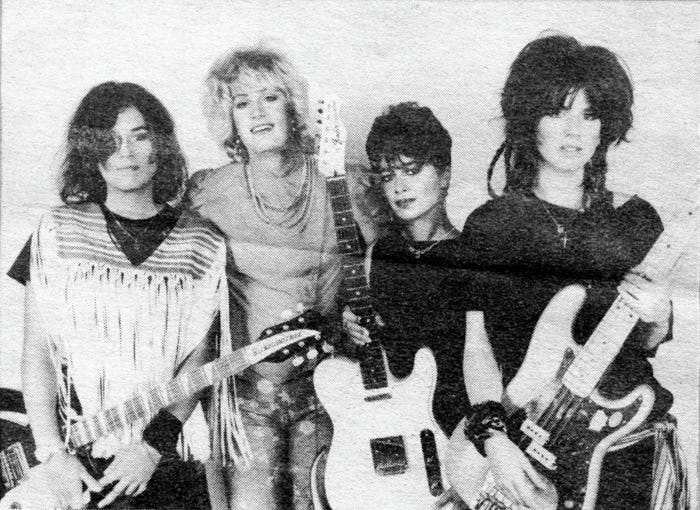
The Bangles were rehearsing and writing, re-working songs for their forthcoming debut album which opens up the possibility that, yet again, there are further demos that remain unreleased. Recording for what would become known as ‘All Over Place’ began in December 1983. Recording had been delayed because producer David Kahne had been working with Romeo Void on their album ‘Instincts’, with recording commencing in October/November 1983, thus giving The Bangles extra time to develop material for their forthcoming LP. The band had approached Kahne after being impressed with his production work on Rank and File’s ‘Sundown’. Around this time, the band taped a loose cover of ‘White Rabbit’, presumably recorded in November 1983 as the rough recording references J.F.K. [marking the then 20th anniversary since the President’s assassination], evidence that the band were recording rough demos in the run up to ‘All Over The Place’ and that it’s likely that there are more.
Recording ‘All Over The Place’ took three months although the studio process lasted just about four weeks. With this time frame in mind, ‘All Over The Place’ was likely recorded between December 1983 to February 1984 [the completed album did not note recording dates]. During the December ‘All Over The Place’ sessions, the band recorded their very first Christmas tape which would soon be issued to fan club members through Bangles ‘n Mash. Channelling The Beatles, the holiday tape featured energetic guitar jams — and originals including a piece entitled ‘Tuesday At Three’ — to well wishes of Christmas and Hanukkah with some loose covers placed in between. The band parodied Trio’s 1982 song ‘Da Da Da (I Don’t Love You You Don’t Love Me Aha Aha Aha) and Patti Smith’s ‘Gloria’ from 1975 with a segue into Van Morrison’s ‘Gloria’. The holiday mix was concluded by a haunting rendition of ‘Silent Night’. The tape would eventually be remastered and reissued in 2004 as a limited edition CD entitled ‘Holiday in Bangleonia’ and sold through the band’s official site.
‘All Over The Place’ was tracked at Crystal Sound, Skyline Recording and Soundcastle, and mastered at Sterling Sound in New York City. The album, consisting of a majority of originals, featured just two covers as it showcased the writing partnership of Hoffs/V.Peterson in a way that no further 1980s era album would highlight [‘All Over The Place’ featured solo writing credits for Vicki on the remaining four numbers]. Arriving on record on 23 May 1984, ‘All Over The Place’ was unique in the way that the vinyl did not include a lyric sheet [the Japanese release was the only version of the LP to feature lyrics in both English and Japanese]. This was a deliberate move by the band because they desired the album to be a ‘headphone record’, and for listeners to hear the ever present vocal harmonies and jangly guitars. Unlike the recording of the debut EP, which was recorded quickly with the band mostly standing and playing, the recording process of ‘All Over The Place’ gifted the band time to search for the right sounds and have fun while doing so. Vocals were tweaked to their own preference and were mixed “way up front” so that they were the main focus on each song. The band described the recording process of ‘All Over The Place’ as an amazing experience but one that had both its ups and downs.
“The combination of our voices and the guitars, nobody’s really done that sort of folk singing thing with the high-powered rock thing behind it before. It’s really tricky to do sound for us- we’ve confunded several sound engineers.” — Michael Steele
The press release which accompanied advanced and promotional copies of ‘All Over The Place’ opened with shots fired at the band’s critics:
“Someone actually had the audacity to suggest the music was so good they didn’t play all their instruments on the debut EP. Wrong, poison pen. They write ’em, they sing ’em, they arrange ’em and they PLAY ‘em.”
‘Hero Takes A Fall’ was released as the album’s first single one week before ‘All Over The Place’ arrived in record stores [information obtained from a Bangles n’ Mash newsletter] and would be reissued and remixed in January 1985 to coincide with the band’s first European tour. A music video for ‘Hero Takes A Fall’ was filmed on San Francisco’s Market Street in May 1984 which placed the band in various scenarios as mannequins come to life [three years before The Mannequin] as they navigated various obstacles.
‘Hero Takes A Fall’ is probably one of the best, if not the best, writing collaboration between Hoffs/V.Peterson. It was the hit that should’ve been but ultimately never was. The punchy bass line introduced by harmonies opened one of the most underrated pieces from The Bangles mosaic; the band’s debut album. From the catchy lyrics inspired by reading literature related to Greek Tragedy [‘The hero is exposed when/his crimes are brought to the light of day’] to the repeated chorus, ‘Hero Takes A Fall’ is the version of The Bangles that should be gifted airplay. The song at the time was rumoured to be about Steve Wynn but the inspiration source is something that the band remains deftly coy about. Was ‘Hero Takes A Fall’ about another musician on the music scene? Most likely. At least one early demo exists which features Sue and Vicki improvising the tempo of the song.
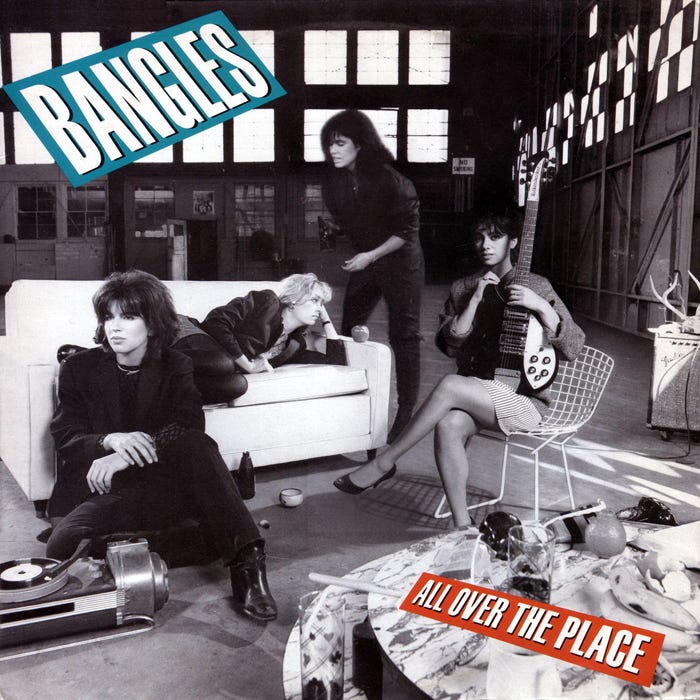
‘Live’ — originally by The Merry-Go-Round — introduced Debbi’s voice to 1984, her first studio lead since recording 1982’s ‘I’m In Line’ [‘Live’ had been a staple of the band’s set since early 1982]. 1967’s ‘Live’, written by singer-songwriter Emitt Rhodes, sounds happy and joyous but there’s a layer tugging away in the background, hinting at something else. The Bangles had once met Rhodes in 1982, tracking him down via the art of sixties sleuthing and noted his then bitterness towards music (decades later, they would eventually reunite to record with him).
‘James’ — a song inspired by a college roommate of Vicki’s who was involved with a professor — was about another failed relationship and one that didn’t sound too healthy [‘I must be a masochist / To ever take up with you James’] delivered a harsh blow. ‘All About You’ was written by Vicki and often extended when performed live, the band offering up a building jam during the bridge, twinged with Michael’s heavy bass line often in the midst of band banter. You can hear the early jangly roots of the band blending through from ‘82 but, then again, they never really left. ‘Dover Beach’ showcased the band’s folk-pop side with twinges of one of the band’s heroes; The Byrds, and was a favourite track of Michael and Vicki’s to perform. Sharing its name with a Matthew Arnold poem, ‘Dover Beach’ also paraphrased lines from T.S Eliot’s poem ‘The Love Song of J. Alfred Prufrock’ [‘In the room the women come and go/Talking of Michelangelo’]. The band’s lyrical references to literature would be continued on 1988’s ‘Bell Jar’; an overlooked Sylvia Plath inspired number written by the Petersons.
Side 2 of ‘All Over The Place’ was kicked into gear by ‘Tell Me’. The song, showcasing the writing partnership of Hoffs/V.Peterson, was a highlight of the band’s debut album, and one that would ultimately fade away with the band’s future commercial success. ‘Tell Me’ was being performed as early as April 1982 and offered up a bass-line that may have been the Paisley Underground’s answer to the one found on The Who’s ‘My Generation’. ‘Restless’ was a prominent number in the band’s set, and was also being performed as early as 1982 with an alternate arrangement and lyrics.
‘Going Down To Liverpool’ was the second cover of the band’s debut album and the second lead outing by Debbi. Originally recorded by Katrina & The Waves in 1983 and written by Soft Boys and Waves guitarist Kimberley Rew, ‘Going Down To Liverpool’ offered up a direct glance into Jangle Pop. The song had been discovered in demo form just by chance by Vicki and Michael after a mutual friend of their roommate had sent over a cassette which included Kimberley Rew’s original version of the song. ‘Going Down To Liverpool’ was the second single to be released from the band’s debut on 17 September 1984. A subsequent music video was filmed and directed by Tamar Hoffs, featuring longtime family friend Leonard Nimoy as the band’s chauffeur. ‘Going Down To Liverpool’ began circulation on MTV, with Debbi and Sue once appearing on MTV News to publicise the release. The music video for ‘Going Down To Liverpool’ was produced by Matthew Hintlian.
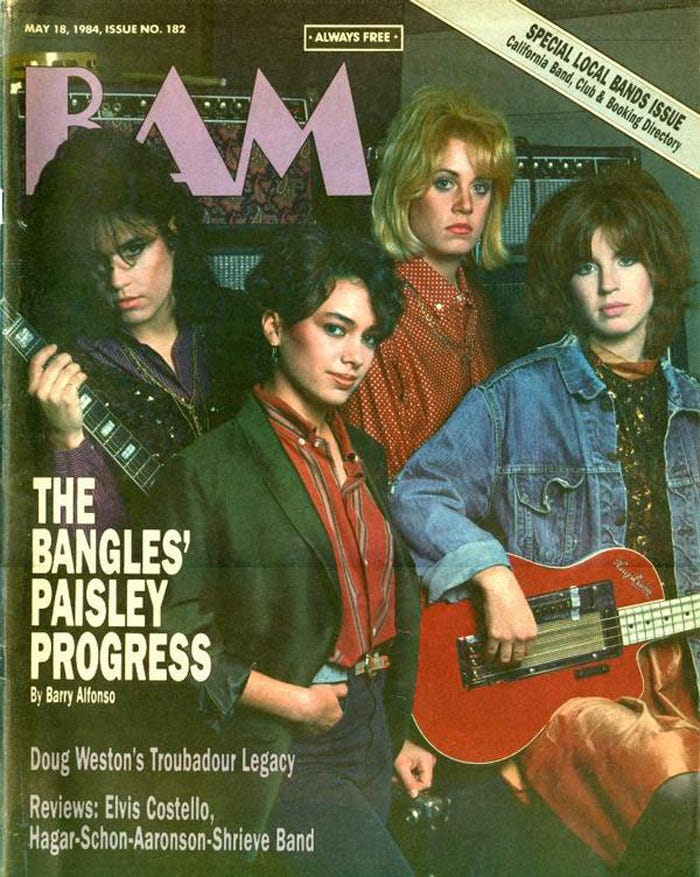
The band’s unique vocal harmonies and love for jangle emerged on ‘He’s Got A Secret’, a prominent number that was performed during the Where Bangles Go Trouble Follows Tour. Hints and echoes of surf rock emerged on ‘Silent Treatment’ and highlighted Vicki’s usage of a Marshall combo amp. ‘What goes through your head /better left unsaid’ was possibly the lyrical sequel to the splintered words thrown down on ‘James’. The most operatic song from ‘All Over The Place’ and, arguably, from the entirety of The Bangles’ career — ‘Eternal Flame’, eat your heart out — ‘More Than Meets The Eye’ featured strings and violins against Vicki and Debbi’s isolated harmonies, and was standalone in the era of heavy synths and keyboards. If there were going to be strings on the record, they had to be real. ‘More Than Meets The Eye’ concluded the band’s debut album in a way that no other song on ‘All Over The Place’ could. It’s not known if the band ever performed ‘More Than Meets The Eye’ in concert but if they did, the attending crowd would have been gifted a haunting acapella performance that adeptly showcased the resolute vocal harmonies of The Bangles.
‘All Over The Place’ featured just one non-album b-side. ‘Where Were You When I Needed You?’, a cover of a 1966 song by the Grass Roots, was recorded during the band’s studio sessions but failed to make the final cut, and was instead released as the b-side to ‘Hero Takes A Fall’. The band had been performing ‘Where Were You When I Needed You?’ as early as 1981.
Vicki said of ‘All Over The Place’ in 1984;
“We feel good about the record. It’s just hard to describe it because I have no idea how people are gonna accept it. Don’t expect anything and expect everything because there’s a lot of variety on the record. I think it sounds like what we’ve been wanting to do for a while. It’s still got a good rock feel to it, it still has pop sensibilities. Our influences are there but it also sounds modern.”
Sue added to the background of the album title; “There’s an incredible amount of variety on the record. That’s why we called it ‘All Over The Place’.”
The release of ‘All Over The Place’ on a major label, Columbia Records, brought the band central media coverage. During an interview with Rolling Stone Magazine in mid-1984, Debbi Peterson remarked that the band’s goal was to become “the next Beatles”, a line that became a central talking point for the majority of critics. Debbi clarified her remarks in November 1984: “That was just a writer looking for a ‘hook’ for his story. The Beatles thing has been totally blown out of proportion. When I said we wanted to be The Beatles it was a total joke! Nobody could be The Beatles.”
Continually downplaying the remark, the band stated that the comment had been misconstrued. “We don’t want to be that. We want to be the next Bangles.” Vicki was quoted in response during an interview but that didn’t stop the critics.
‘Bangles beatle with ‘mop top’ era sounds’ captioned the Calgary Herald (25 August 1984)
‘Listen, and you’ll hear the Beatles’ (The Times Leader, 7 September 1984)
‘Bangles: A female Fab Four?’ (Arizona Republic, 12 September 1984)
‘Bangles: A Female Beatles?’ (St. Louis Post-Dispatch, 14 September 1984)
The headlines continued:
‘Bangles return to Beatles’ (The Daily Journal, 28 November 1984)
‘The ‘Bangles’ Have A Beatles Influence’ (The Signal, 30 November 1984)
‘An all-female band inspired by Beatles’ (The Philadelphia Inquirer, 2 December 1984)
‘Bangles Using Sound Similar to Early Beatles’ (The Town Talk, 6 December 1984)
‘Introducing the Beatles, er, Bangles’ (Wisconsin State Journal, 23 December 1984)
‘Bangles sidestep Beatles curse’ (The Jackson Sun, 28 December 1984)

As well as the comparison to The Beatles, The Bangles were held in rank to another band. Unimaginative critics continually voiced comparison to The Go-Go’s, something which, rightly, annoyed. The comparison became even more prominent after the band signed to Columbia Records but had been pinned by critics since the release of ‘Getting Out Of Hand’.
“We really have nothing to do with them.” Susanna said in May 1983 in response to the comparison; “We didn’t get started because of them. Our musical influences are completely different. We sound different. We are different. We’re different people.” The band continually deflected the comparison with eye rolls and wit — Sue once joked that she was Jane Wiedlin in a wig — although critics continued to write about it. “We don’t worry about it.” Vicki said of the comparison in April 1983:
“There’s room for all of us. We have faith that our sound is accessible enough to eventually get radio play, and we want radio play, we want that exposure and accessibility but we have a different sound and we’re not the same band. It’s silly because you’re going to have more and more female musicians coming to the fore in rock music all the time. There will be more and more female musicians doing their own material and doing their own thing so it’s going to become less and less of a novelty and people will start looking at the acts for their own individual worth. We hope.”
Critics also frequently highlighted the fact that the band was all-female, a key reflection of how unique that was for a guitar band during the 1980s, but it was something which perplexed the band. The Bangles didn’t see why it mattered that they were women or why their gender seemingly defined the music that they wanted to play. “Percentage wise there are fewer all-girl groups so people focus on them.” Vicki commented, although she remained hopeful that more would come into prominence, “I am hoping more and more women will get it together to play. Rock music needs a good kick in the pants!”
‘All Over The Place’ was received with generally favourable reviews:
“The big guitar sound that has made such a comeback in British rock is also in evidence here, with Vicki Peterson and Susanna Hoffs weaving strong rock lines and offering solos. The guitars, voices and songs all add up to an album that begins revealing its own considerable merits.” — The Town Talk, 2 August 1984.
“Prolific Vicki Peterson, the group’s lead guitarist, provides the bulk of the original material, either alone or with Hoffs.” — Daily Record, 12 August 1984.
“Instead of the surf — punk blend of The Go-Go’s, the Bangles are mining the psychedelic ‘60s in an energetic, involving way. The songs on this album echo everyone from the Buffalo Springfield to early Jefferson Airplane; they’re strong on melody, with lyrics that propel the tunes but don’t overwhelm them.” — Florida Today, 21 September 1984.
“None of the songs are blatant copies of one specific group, they are an amalgam of influences. In the end, the lyrics and feelings are clearly those of The Bangles. “All Over The Place” is an excellent debut, ripe with promise of things to come and memories of days gone by.” — The Desert Sun, 21 July 1984.
The band’s reception was met with equally bold headlines:
‘Bangles pay dues, now ready to roll’ — Fort Lauderdale News, 21 September 1984.
‘LA’s Bangles prove they’re no baubles’ — The Boston Globe, 6 October 1984.
‘The Bangles Are a Rock Band! …And That’s How The All-Women Group Wants To Be Known’ — The Tennessean, 26 November 1984.
Beginning in May 1984, The Bangles toured to support the release of ‘All Over The Place’ and appeared for the second time on American Bandstand in August 1984. Gigging for much of the remainder of the year, the band shared bills with bands like The Three O’Clock, The Beat Farmers, The Go-Go’s, The Psychedelic Furs and The Fuzztones.
The band’s dates with The Psychedelic Furs in August 1984 were met with positive reviews: “The Bangles, out of Los Angeles, offered a 1960s explosion with their short, catchy original tunes…the quartet rolled into supercharged versions of Want You and Hero Takes a Fall.” wrote Arizona Republic regarding the band’s opening slot at the Mesa Amphitheatre on 24 August 1984.

Shortly before The Psychedelic Furs tour began, Vicki joined the line-up of Redd Kross in July. At this time, Redd Kross consisted of Vicki’s then boyfriend Jeff McDonald, his brother Stephen along with Dave Peterson — Vicki’s brother — on drums. Vicki played just one gig with Redd Kross, replacing guitarist Dez Cadena who had just left the band. This show took place at L.A.’s Pomona Valley Auditorium. Footage from this gig is featured in the 2010 rockumentary A HISTORY LESSON PT 1. During the same month, The Bangles shared the bill with The Three O’Clock and Chardon Square at the same venue, playing the unique addition of The Rutles’ 1978 ‘hit’ ‘Number One’. The Rutles, known for their parodies of the Beatles, toured and recorded. Other popular covers around this time included Paul Revere & The Raiders’ ‘Him Or Me (What’s It Gonna Be?)’, ‘Open My Eyes’ by Nazz and the band’s version of The Salvation Army’s ‘Going Home’ which, like The Mamas And Papas’ ‘Creeque Alley’, also became a prominent addition during 1985 sets.
“When you’re a local underground band, no one really cares about you. Now we’ve noticed more people coming to our sets know our names. That never used to happen before. The audience is much more frenzied now.” — Debbi Peterson
During the following September and October, The Bangles were set to open for A Flock Of Seagulls but most of the tour dates — much to the band’s disappointment — were cancelled. The Bangles, to replace the shows, acquired bookings for headline sets. A prominent headline show took place at Fort Lauderdale’s Summers On The Beach on 22 September 1984. The band’s midnight slot was met with rave reviews:
“The band, which blends gritty guitar playing with soft, airy two and three-part harmonies, proved that it can indeed pull off that appealing combination in concert without studio tracks. In fact, some of the band’s songs, especially the first, single Hero Takes A Fall, sounded better live than on record. Guitarists Vicki Peterson and Susanna Hoffs, drummer Debbi Peterson and bass player Michael Steele, certainly work hard in front of an audience and seem to have fun performing.” — Fort Lauderdale News, 28 September 1984.
The band’s replacement headline sets took place in smaller venues than the scheduled venues for A Flock Of Seagulls. One of the band’s clubs shows took place at The 688 Club, Atlanta, GA on 25 September 1984.
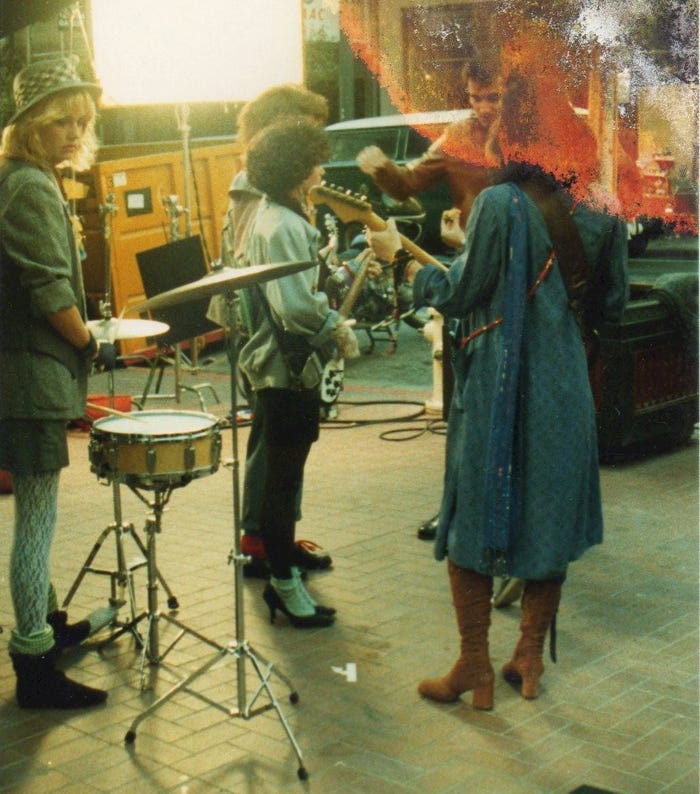
The band’s gig at the New York Ritz on 28 September 1984 is of note because it is preserved in a high-quality soundboard recording and was broadcast on New York radio station WLIR. The Bangles, however, were not originally scheduled to play at The Ritz on this date and were originally scheduled to open for R.E.M. at the USF Soccer Stadium in Tampa, Florida.
The band’s gig at The Ritz displayed a group on the cusp of something greater but not necessarily better, and is yet again another missing piece deserving to be officially released by the band. The biggest tour of 1984, however, began in early October when The Bangles were selected as the opening act for the North American dates of Cyndi Lauper’s ‘Fun’ Tour after A Flock Of Seagulls dropped out.
The ‘Fun’ Tour opening slot lasted from October to December 1984. Venues covered included Dallas’ Reunion Arena, Florida’s TLCCC Theater, The State University of New York and Minneapolis’ Roy Wilkins Auditorium. Reviews were mainly positive: “The evening was made complete by a top-notch 45 minute opening set from the group The Bangles… The feminine half of the human population wasn’t let down Sunday night in the Civic Center.” wrote the Tallahassee Democrat, 23 October 1984. “After initially experiencing trouble with the sound mix, the LA-based quartet came together for a superb set, owing more to the Pretenders and Tom Petty for their sound than the Go-Go’s, who The Bangles have been compared to.” critiqued the Tampa Bay Times, 29 October 1984, regarding the band’s show at Florida’s Bayfront Center. New York’s Press and Sun-Bulletin were less favourable about the band’s show at the State University, writing on 11 November 1984: “The band failed to live up to its claim of ‘We’re the female Beatles.’ In fact, their set was quite colorless and lacked any cohesive drive or substance.”
The band’s opening set for the ‘Fun’ Tour consisted of 12 songs that mixed together material from ‘All Over The Place’ and the band’s self-titled EP. A prominent point of interest noted by reviewers was when Lauper would bring The Bangles back on stage for the encore performance of ‘Girls Just Want To Have Fun’ with the band providing backing vocals.

During the ‘Fun’ Tour, The Bangles appeared on Late Night With David Letterman on 16 November 1984. Opening for Lauper exposed the band to a bigger, more mainstream audience and a much younger crowd as they began to play in larger venues for the first time since The Beat tour of Winter ’82. Interestingly, during this time, the band would often play intimate club shows on the same night as opening for Cyndi Lauper. One fan recalled seeing the band perform at The Royal Blue in Gainesville in October 1984 where they were, in his words, a ‘distaff Beatles with beautiful harmonies’. Other club shows played during Lauper’s ‘Fun’ tour included Chicago’s Cabaret Metro and Club 950 Lucky Number, Detroit’s Clutch Cargo’s and San Antonio’s After Sundown.
It’s disappointing that bootlegs from this time are extremely rare. There is knowledge of other existing soundboard recordings but, to much disappointment, they have never been released. The band are known to hold a large number of recordings in the archives. As one of the most interesting aspects to The Bangles, the ‘All Over The Place’ era needs to be revisited and explored in a meaningful way by an official release.
“It really matters when you get letters from kids who’ve heard you on the radio. A song can affect their lives, just like the songs we heard on the radio did ours. It’s really exciting that you could texture somebody’s thoughts that way.” — Susanna Hoffs
The band’s abilities weren’t limited to strictly music. Dave Markey’s film, made in collaboration with the McDonald brothers of Redd Kross, Desperate Teenage Lovedolls premiered in October 1984 at the Lhasa Club [two years after hosting The Bangs EP release party]. Desperate Teenage Lovedolls featured a cameo appearance by Vicki as a ‘hippy mob killer’. Desperate Teenage Lovedolls was a low-budget film shot on super-8 about a band of teenage runaways.
Another project featuring Bangles alumni was ‘Neighborhood Rhythms (Patter Traffic)’, a collection of spoken word poetry. First noted in The Los Angeles Times, on 23 September 1984, the album was released on Freeway Records in November 1984. The collective was produced by Harvey Kubernik and featured an eclectic range of L.A. alumni. Michael contributed ‘El Pollo Loco’ to ‘Neighborhood Rhythms (Patter Traffic)’, showcasing her poetry on record for the very first time. ‘El Pollo Loco’ told of a time in mid-1983 when Michael and a friend met a Hispanic man who had been tortured in El Salvador. It was a political piece and a fragment of The Bangles which, like most other aspects, is normally overlooked.
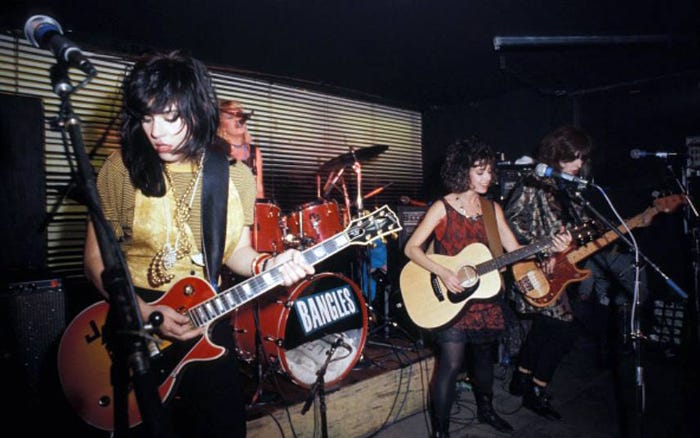
Returning home from a busy touring schedule meant that the band’s annual festive tape was delayed until January 1985. The band had gigged near weekly since the release of ‘All Over The Place’ in May 1984. The late holiday tape was opened by New Year wishes followed by a rocking jam incorporating the riff of Iron Butterfly’s 1968 song ‘In-A-Gadda-Da-Vida’ with lyrics reflecting the New Year. The tape featured thank you messages, spoken word randomness which included Sue jokingly singing ‘Tomorrow’ from the Broadway musical Annie and a band jam incorporating the olde Scottish poem ‘Auld Lang Syne’.
1985 began with a number of club shows. One of the earliest gigs the band played took place at New York’s Scorgie’s on 5 January 1985. These January shows were the warm-up to the band’s first European tour which began a month later. A key TV appearance made during February 1985 was on British music show The Tube, which aired three days after the band performed at London’s Dingwalls. Live on The Tube, the band’s performing debut on British TV, The Bangles sounded raw live yet retained their power. It was an emotional experience for Debbi who, after the performance of ‘Going Down To Liverpool’, was moved to tears. The Peterson sisters also appeared on an interview segment on The Old Grey Whistle Test which aired on the same night as the band’s London show on 12 February. “From talking to people here, it seems that it’s not that usual this side of the pond to have women who can play, and it’s competent and it’s fun.” Michael Steele said during the tour, an accurate reflection on the then British music scene.
The 1985 European tour is preserved in bootleg recordings, many gig reviews and multiple radio station broadcasts. The band’s sold-out gig at Dingwalls on 12 February 1985 was broadcast on British radio, gifting the band with added promotion. The band’s show at the Amsterdam Melkweg on 16 February was also broadcast over Dutch airwaves. The European tour was well received, having been promoted in ads in major music papers like the New Musical Express and Sounds. Most British critics, however, did not immediately warm to The Bangles. Writer William Leith voiced his views in an incredibly sexist review of the band’s show at Dingwalls, one which remarked on “clean panties” and “pouty lips”:
“The Bangles, some of you will say, are good for one off the wrist, not the ideal sexual fantasy but a copy of the ideal sexual fantasy.”
A British review of ‘All Over The Place’ critiqued by Don Perretta opened with: “Mysteriously, when presented with an all-girl band, some reviewers’ critical capabilities all but disappear — for some reason they find it necessary to make concessions because they’re female. Bangles are just another case of this appallingly patronising attitude.” The writer then goes on to acknowledge the band’s talent before adding — in the same sentence — that they should only record songs that are chosen for them. The topic of the band’s supposed image — as being viewed as a manufactured gimmick — was once broached by Sue in August 1984:
“What bothers me more than anything is that some people see us as some sort of gimmick. Those people might not listen to us because they might think we’re cheap and manufactured. To us, the music is coming from our hearts and souls. I mean, we really like to rock.”
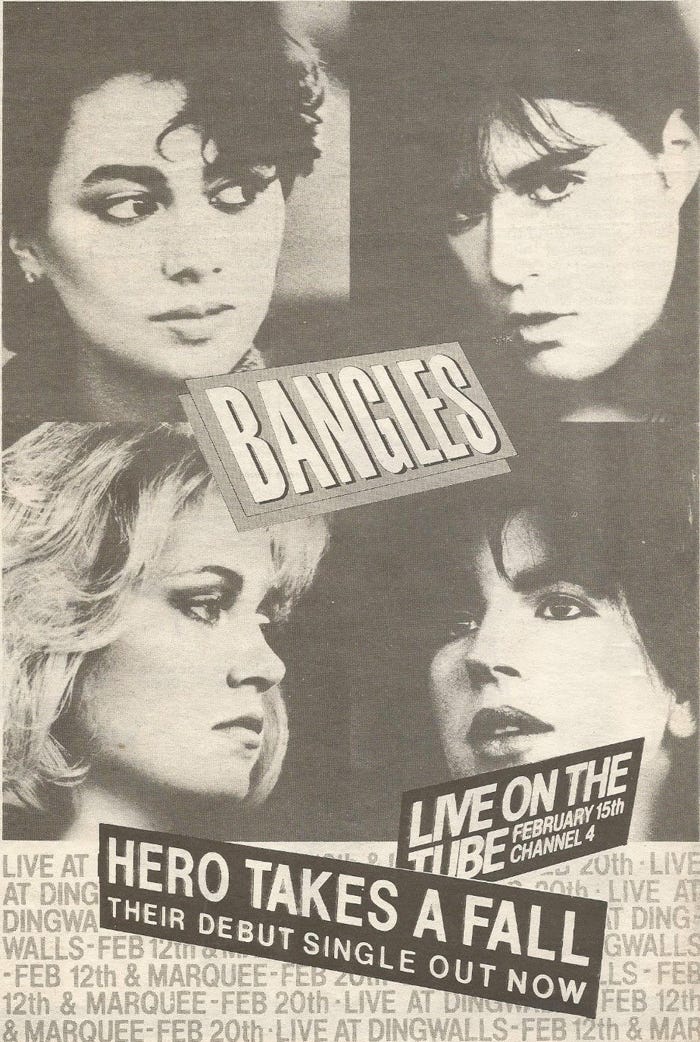
In March 1985, back home in California, The Bangles participated in ‘Trouble in Paradise’, a three-hour benefit concert organised for the homeless. Taking place at The Palace on 10 March, ‘Trouble in Paradise’ featured a vast array of rock alumni including Brian Wilson, Christine McVie, Jackson Browne and Ray Manzarek. The Bangles performed The Crystals’ 1963 song ‘Da Doo Ron Ron’ alongside Brian Wilson and Jackson Browne, and The Mamas & Papas’ 1965 cover ‘California Dreamin’. Susanna also performed The Grass Roots’ 1968 cover of ‘Midnight Confessions’ alongside Belinda Carlisle and Molly Ringwald. The benefit concert is immortalised in bootleg form.
Vicki appeared on touring friends The Beat Farmer’s song ‘California Kid’. The Beat Farmer’s ‘Tales of the New West’ was released in March 1985. Around this time, The Bangles expressed interest in publishing unreleased songs from Paisley Underground alumni on Downkiddie Records, music which included songs by friends The Three O’Clock, but ultimately the project never materialised.
The next major project for the band took place when they were asked by their friend Cyndi Lauper to be included on the soundtrack for a forthcoming film called The Goonies. Lauper had been promoted to musical director of The Goonies soundtrack by Executive Producer Steven Spielberg. The band’s contribution to the soundtrack was first mentioned in The Los Angeles Times on 28 April 1985, the same day they appeared as presenters on The Cutting Edge. ‘I Got Nothing’ was written by Vicki, Susanna and Jules Shear. The Bangles had first met Shear at a charity event, striking up conversation, and once — in early June 1985 — accompanied him on American Bandstand where they stood in as Shear’s backing band [The Bangles would revisit Shear’s ‘If She Knew What She Wants’ during the ‘Different Light’ sessions.
The Goonies was released on 7 June 1985 and was the first major feature film to include a Bangles song. There are at least two versions of ‘I Got Nothing’. The version which is included on The Goonies soundtrack [released on 15 July 1985] and an alternate take which was accidentally included on 2004’s greatest hits compilation ‘The Essential Bangles’. The alternate take features a different drum track, a variation on backing vocals and the guitar solo. ‘I Got Nothing’ was also the first Bangles song on record to feature Michael Steele singing lyrical lines although she had been performing ‘I’m Not Talkin’’ live from as early as 1983. ‘I Got Nothing’ was performed at least once on TV during the March of Dimes telethon in late June 1985 which was one of the band’s final performing appearances — if not the last — before recording commenced on the band’s second album.
Another project related to The Goonies was the band’s cameo appearance in Cyndi Lauper’s music video for ‘The Goonies ‘R Good Enough’. The band cameoed as pirates alongside a group of WWF Pro-Wrestlers which included Wendi Richter, Rowdy Roddy Piper and The Fabulous Moolah. The music video was filmed after the completion of The Goonies and debuted on MTV in two parts. The first part aired just before the movie opened in theatres and the second, with the band’s cameo, debuted just after the movie was released.
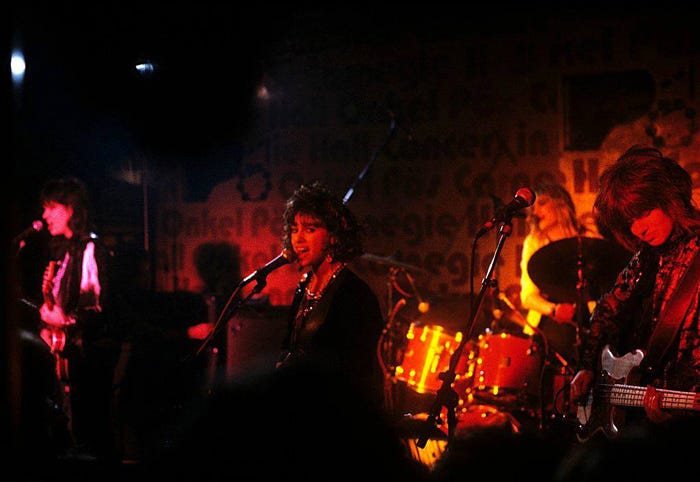
In July 1985, recording commenced on the band’s second album which would go on to be known as ‘Different Light’. The Bangles were still in the process of recording the sophomore album in August with the basic rhythm tracks being completed. Between the less than enjoyable recording experience, the band made various TV and radio appearances. Susanna appeared on a musical segment on ABC’s 20/20 with Molly Ringwald. The jam session featured Ringwald on lead with Sue on tambourine. KROQ’s Rodney on the ROQ was hosted by the duo during the same month as a guest hosting slot by The Bangles. The band were also ‘interviewed’ for F.T.V, a parody of MTV which didn’t air until later in the year.
‘Different Light’ was completed by September 1985. The band’s final day in the studio was on Saturday 14 September 1985, the album arriving with Columbia Records just two days later. ‘Let It Go’ was the final song of the album to be recorded and, initially, was set to be a non-album b-side with the early working title of ‘Let It Go! (Theme from Beyond The Valley of The Supersonic Bangs)’. ‘Let It Go’ is the only song during the band’s 1980s catalogue to be accredited to each member and, after receiving initial positive reception with the label, made it to the record. The Bangles, at this time, were planning an international tour in January, initially proposing the addition of Vicki on keyboard. ‘Different Light’ had a tentative release date of January 1986. The album would eventually be released on 6 January 1986.
A compilation of I.R.S. artists was first proposed in November 1985. This compilation was set to include either ‘Hero Takes A Fall’ or ‘Tell Me’ recorded from London’s Dingwalls on 12 February 1985. ‘Hero Takes A Fall’ was eventually selected for the compilation and released as part of ‘Live! For Life’ in April 1986. Also taking place in November 1985, Debbi was endorsed by Zildjian Cymbals, a major recognition so early into the band’s career. A notable appearance by The Bangles during this month was at a Peace Walk fundraiser held at U.C. Irvine; an anti-nuclear rally which was staged to raise financial and moral support for the Great Peace March which would take place in March 1986. During the Peace Walk, The Bangles signed autographs and performed a set of acoustic songs.
At the CMJ Music Awards on 9 November 1985, Michael and Sue supported R.E.M. during the band’s acoustic set, providing backing vocals alongside Peter Holsapple to ‘Don’t Go Back (To Rockville)’. This performance is immortalised in a rough recording.

The band’s annual festive tape arrived on the doorsteps of Bangles ‘n Mash members in December 1985. The first mention of the tape arrived in the Bangles ‘n Mash December newsletter with the mysterious message of “He puzzled three hours, till his puzzler was sore”; a Dr Seuss reference. The tape featured carol singing, Michael’s ‘Pee Wee Herman’ voice, and an “obligatory” L.A. band poetry reading amongst guitar jams.
The tape revisited the earlier rocking version of ‘Auld Lang Syne’ which it concluded on. The Bangles, at the time of recording, only dreamed of having a number one single and, on reflection, there’s something special about Vicki’s foreshadowing words, knowing what would become in the months ahead. It’s interesting to hear Vicki converse on touring all throughout 1986 because they would have a number one single and Sue’s remarks about booking all ages show. With the band’s future commercial success, this became true as not only were they playing clubs, they were selling out larger auditoriums, playing festivals and venue halls all throughout America and Europe.
And… everyone really knows the story from there. The early pre ‘Different Light’ era of the band will always be my favourite and for many reasons. I am endlessly grateful that I was able to unearth the music of The Bangles just by chance; to peek past the shiny glossiness of the band’s later hits to find an interesting band that has been discarded so obtusely by rock history. It’s extremely sad to see what became of the band’s legacy and how poor in preservation it continues to be. I don’t think I’ve ever known another band as corrupted by the ‘singles canon’ than The Bangles are because the most interesting songs will never be found on ‘Greatest Hits’ compilations. Fame and radio play do not necessitate a greater importance or superiority. That’s the biggest misconception in rock music. Just imagine if ‘Hero Takes A Fall’ garnered as much airplay as ‘Manic Monday’, ‘Walk Like An Egyptian’ and ‘Eternal Flame’ do, and how refreshing that would be. The Bangles deserve to be defined by more than three songs just like any other band that dared to strum. What about some spin of ‘More Than Meets The Eye’, ‘Let It Go’, ‘Watching The Sky’, ‘Get The Girl’, ‘Ride The Ride’ and all the others? There’s a rich catalogue awaiting to be discovered. The Bangles story doesn’t begin and end with ‘Different Light’ and isn’t that a great thing?
“That’s encapsulation. ‘They were cool, they sold out’ and what I want to say is, you know, this is why we’re playing live… is that — excuse me — we rocked! You know, we were a really good, albeit, slightly thrashy and not perfect by any means, rock band. And I think until we get out there and play again, and people have a chance to see us, they’re not going to know that. They remember something about a beach and an eternal flame, and they remember the ‘we walk like an Egyptian’ that were in the videos. Which is great. I mean, it’s great to be remembered at all but I think it’d be nice to go back and point to the people who weren’t diehard Bangles fans, who knew every word of every song, that there was a lot more to this band than the top forty hits.” — Vicki Peterson
I will always cringe whenever I see The Bangles being reduced to non-musicians, non-songwriters, placed on a crumbling mantle next to dusty soulless groups like Bananarama or Pat Benatar who I mentioned at the beginning of this piece. Maybe it was the frightening notion that four women could write together, play together, sing together, and function in a band together that is still so doubtful to this day. Why is the sight of women wielding guitars still so threatening, and so worthy of condescension?
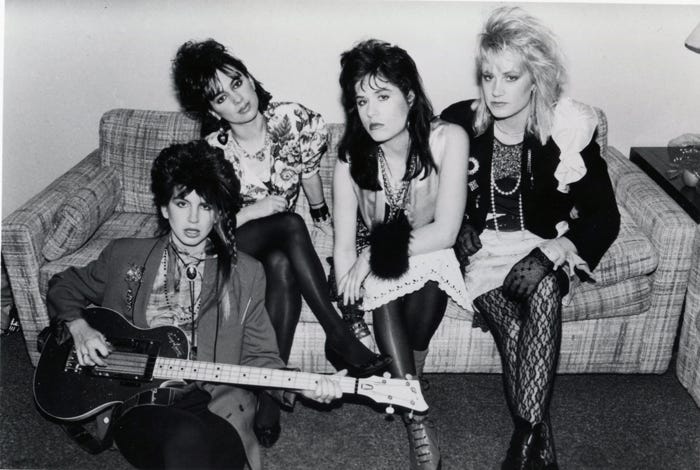
I have grown increasingly tired of observing the band’s unfair exclusion from the rock canon, and the casual disregard of everything the band recorded prior to 1986. Female fronted rock, unlike so many believe, did not leap from the 1970s into the Riot grrrl movement of the 1990s. There was no singular, structured path as is often implied. I’ve researched this subject at great length and it still baffles me that The Bangles are excluded from 99.9%, if not all, media relating to the very subject of ‘female rock’. They formed off their own backs, they played guitars and they wrote their own songs so why the continuous mistreatment?
Lengthy discussions have lead me to believe that this is due to their commercial success which is something else entirely. The early years of the band are often mentioned in connection, and a popular reason, for bashing The Bangles for their later commercial success. If commercial success — or just success— is viewed negatively as The Big Bad of “selling out” how can this be true when The Go-Go’s continually gain coverage, and they are deemed as “the most successful all female rock back of all time”? Why do critics refrain from discussing the early beginnings of The Bangles; daring to scrape the surface of ‘All Over The Place’ and everything that went before?
An example of this — of how critics favour to gloss over the band’s career — features in an article in SHINDIG! Quarterly №3. Entitled ‘This Can’t Be Today’, this Paisley Underground centrefold featured the following harsh words as the writer incorrectly noted Bangles album release dates and titles:
‘…‘85’s In A Different Light, the latter an embarrassing load of glossy, tedious crap. Rarely in pop music history has the charge “sellout” been so applicable.’
The Bangles get a one page mention whilst other bands on the scene get far more, including True West and Green On Red who weren’t even part of the original scene.
The Bangles existed when the music industry was set up in a very structured way for female artists, something which appears to disintegrate amongst rock critics, and certainly the above writer. It was a restrictive time and over the space of four years — from 1985 to 1989 specifically — The Bangles gradually lost more control. That isn’t to say they weren’t bold, they were and in many ways, but to discuss the band you have to place them in context with the time frame they were contemporaries. The 1980s era struggled to understand four female artists who wanted to play and sing, who weren’t a gimmick, and four personalities who were individual in their own right. Commercial success gifted the world 1987’s ‘Hazy Shade Of Winter’ and a handful of tracks on 1988’s ‘Everything’ that will, for some criminal reason, never be receptive to airplay. The Bangles are that band; with music that continually flies under the radar, who are deserving of something greater.
If I could change the history, I would like it to show a better representation of the Bangles. I always felt that things were very one sided. There is a lot more to the Bangles than “Walk Like An Egyptian” and “Eternal Flame”… We all sing and write and it’s very much a band effort. I just wish that had been realized. — Debbi Peterson
There are so many who believe that they were plucked from obscurity and pre-formed by a label which is a very sexist ideology in itself because they happen to be women and women just can’t possess the dual ability to play and write. There also appears to be an inability for critics and fans to refrain from highlighting appearance, lavishing prose on how they looked then and how they look now. This is such a fundamental cliché, a sort of handicap that seemingly restricts overall credibility of The Bangles to be seen for what they are; as artists and as musicians. A perpetuating sexist trait that only withstands when the subject matter is female (“men act, women appear.” John Berger wrote in Ways of Seeing (1972); an apt summary of sexist criticism).
A pivotal example of this inability — the emphasis on how they look — occurred when my blog launched #TheBanglesRRHOF, a positive push and space for the band to be discussed and recognised for their musical abilities. It didn’t even take a day before it devolved into everything I didn’t want it to be, with fans clambering to profess with repeated insistence how beautiful the band are, how they remain ageless and youthful because, you know, that’s essential for 50+ women. They took a positive space and turned it into everything I had set out for it not to be; a shallow discussion focused on looks rather than songs and performances. This is an ever-present clutch that clings to The Bangles with such unshakeable force it’s a little unnerving. I then began to distance myself from something I had created which was yet another blow to a fanbase that already doesn’t have much. There are so many aspects to the band, layered as they are. Everything from choices of guitars to musicianship to song writing, to influences et al that this fascination and lingering obsession on their appearance rather pales in comparison. The band were far more than fashion models or a 1980s cliché, and they deserve better.
The double standards are stark; the thinly veiled sexism of the eighties remains rife and increasingly apparent in the digital age. It can be found in the comment section of every YouTube video and social media post relating to The Bangles. The internet is a shiny glass case of misogyny; on display for everyone to see, and polished at a depressingly alarming rate. When I set up my blog’s channel for sharing videos, I began collating screenshots of comments I received, ones which are, shall we say, radiate a specific kind of stupidity. It became a kind of art project and shocking in many ways for you wouldn’t believe the kind of junk people feel safe enough to write when shielded by the digital cloud of anonymity. Or maybe you do. The internet brews cynicism, and social media even more. It’s a dark place. Such a dark place that you have so called “fans” assembling falsities and appearing as the artists themselves, using namesakes as they pretend to be the person who they worship, spewing exaggerations and untruths at every corner as they seek to mislead and manipulate trusting fans. The Bangles, once again, deserve better.
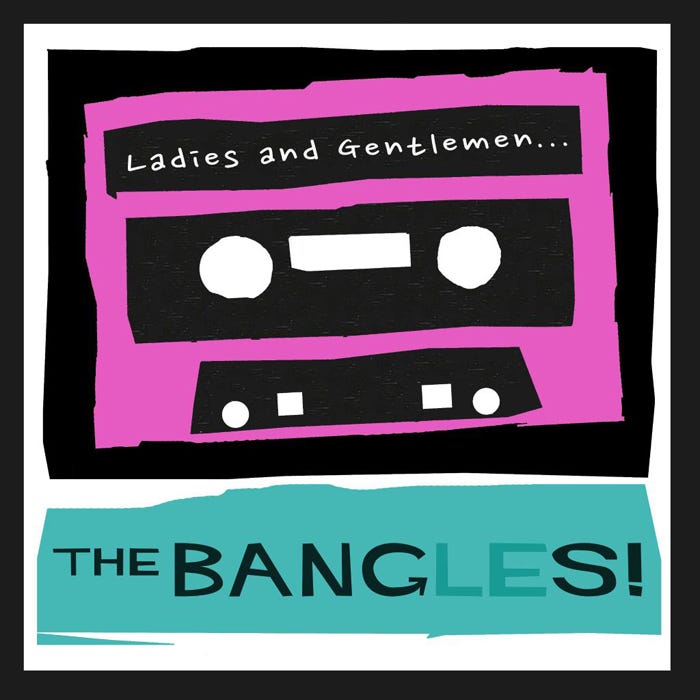
Unfortunately, this situation is not only a product of rock critics or even of social media, but also one resulting from the band’s strikingly casual and careless attitude towards their own legacy, thus leaving a vast category of things missing for fans. At the forefront of all of this is remastered releases assembled with care. It’s actually quite astounding how much is missing when it’s quite obvious that there are a number of shows and outtakes gathering dust in the archives. 2014’s ‘Ladies And Gentlemen… The Bangles!’ was an extremely small step in the right direction but even this release was marked with a few setbacks. It arrived initially as a digital release that spent two years before finding its way onto CD and vinyl with a mislabel (the live track ‘Tell Me’ was recorded in London in 1985 and not 1984). The aforementioned track was actually broadcast on British radio in 1985 which begs the question: why won’t the band officially release the full show? There is so much potential completely being sidestepped because no one really wishes to take the time, care or effort in preserving a rich musical history. ‘Ladies And Gentlemen… The Bangles!’ arrived without proper sleeve notes [no, a digital press release does not count] and I can’t help thinking how much a collection like that would have benefited by a discerning critic’s liner notes, more concrete recording dates (the dates you see in this article have taken much effort to assemble) or even a few introductory words by the band.
The other archive material worthy of a full retrospect are the band’s fan club exclusive releases. Full of Beatlisms, loose demos and other general randomness they display a hungry band having fun regardless of how many records they were or weren’t selling. Fan club material aside, that isn’t even bringing into question the archival video and concert footage that exists. Although unfolding after the era I’ve been discussing, the band’s benefit concert from the Syria Mosque in Pittsburgh in October 1986 is worthy of an official release yet is forever confined to the fuzzy low-quality streaming perks of YouTube. This brings yet another aspect of the band’s career that is poorly preserved.
TV appearances of the band were common; from American Bandstand to MV3 but only two performances of the band have ever been officially released. The band’s performance of ‘Walk Like An Egyptian’ on The Old Grey Whistle Test in July 1986 appears on 2004’s The Old Grey Whistle Test Volume 3 with accompanying commentary that is extremely irrelevant and poor in content. Listen out for the ‘commentators’ swooning over Susanna Hoffs, mixing up band member’s names and just about laughing at the rest of the band. The second officially released archival performance of the band features on 2003’s Saturday Night Live (25 Years Of Music) when The Bangles performed ‘Hazy Shade Of Winter’ during host Danny Devito’s December 1988 episode [the band also performed ‘In Your Room’]. This release also features accompanying commentary added by Al Franken. Franken’s introduction of The Bangles is oddly hostile and he mocks the band. The sexism the band experienced is not discussed enough and is highlighted for all to see — hear — in these dreadful commentaries. It’s very ironic that so-called ‘music critics’ struggle to comment on the music being played, a point which is made all the more effective when listening to these commentaries in conjunction with the other featured artists. While the appearance of The Bangles is remarked on, questions of talent are brought up yet these all fall silent during the coverage of the other male contemporaries.
To imply that The Bangles never experienced sexism is extremely naïve. They spoke out about it on many occasions. The ‘they play okay for chicks’ attitude surfaced as frequently as the ‘how does it feel to be in an all-girl band?’ question did during interviews. A band that were frequently subjected to questions to the effect of ‘which of you slept with Prince?’ definitely experienced sexism — this did happen — and it really makes you wonder if, for example, an all-male band of the era like Duran Duran would have had to endure similar questions if they recorded a song that a prominent female artist had composed. The answer? Not at all.
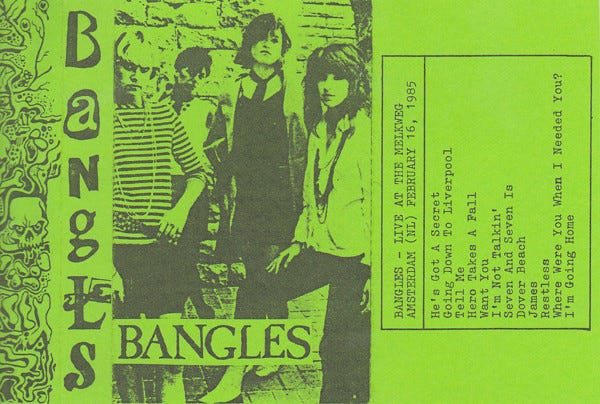
It is extremely odd how scarce 1980s footage of the band is and, again, this negatively impacts the band’s reputation. The two performances I have discussed only highlight how poorly and unfairly treated The Bangles are in comparison to other bands. There are weaker b-list artists from the 60s, 70s and 80s that hold a stronger repertoire in the archival department than The Bangles do. There have been audio concerts released in the past few years — unofficially and often pre-existing bootlegs — which lessens the enjoyment. Artwork for these releases are often from the wrong year and poorly constructed as their labels churn out releases with little care or effort.
Sadly, this lack of effort isn’t strictly limited to unofficial releases, especially when it’s extremely easy to highlight historical inaccuracies on the band’s official site. More rarities are undoubtedly left to gather dust on ageing cassettes and isn’t that just sad? That the band’s legacy remains splintered and so poor in preservation and execution as it continuously fails to be highlighted and explored in meaningful ways that would help highlight the band’s true achievement and legacy. There have been countless album anniversaries which passed by with little more than a bland and uninspiring social media post [the band’s main social media is a poorly maintained and – at times – extremely cringeworthy Facebook page], moments that would have been bolstered by carefully remastered editions, and yet they have all been missed. More recently, the band have acquired an Instagram account, one which is known to ‘borrow’ images scanned by fans (including my scanned copy of ‘Getting Out Of Hand’ as featured in this article). Unsurprisingly, they do not hold the courtesy to credit fans for their efforts.
The missed opportunities are vast and run deep and these fall heavy on the shoulders of the band. There’s laziness and reluctance and, sure, at this point they’re probably more than comfortable to be known forever for the hits, for the overplayed karaoke classics and the success they had. The pre ‘Different Light’ era, however, should not be left in the shadows and overcast by the shininess of chart success. Popularity does not denote superiority. It creates erasure, a catalyst that distorts the band’s history and continues to colour its legacy. There’s more than meets the eye to The Bangles — pun wholly intended — and their earliest years highlight many of the reasons why.
About the Author
You can connect with Rachel’s Bangles blog on Twitter or directly at its URL, banggothebangles.com.
